Illustrations
Explore nearly 400 illustrations and specimens carefully curated by Daniel Updike that document almost 500 years of typographical history. This collection restored from Printing Types shows how letterforms evolved from the earliest printed books in the fifteenth century to the early twentieth century.
Countries
-
 Figure 1
Impression of a piece of Fifteenth Century Type
1476
Figure 1
Impression of a piece of Fifteenth Century Type
1476
-
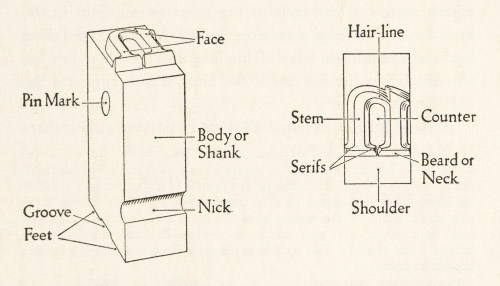 Figures 2 & 3
Diagram of Type and Plan of its Face
Figures 2 & 3
Diagram of Type and Plan of its Face
-
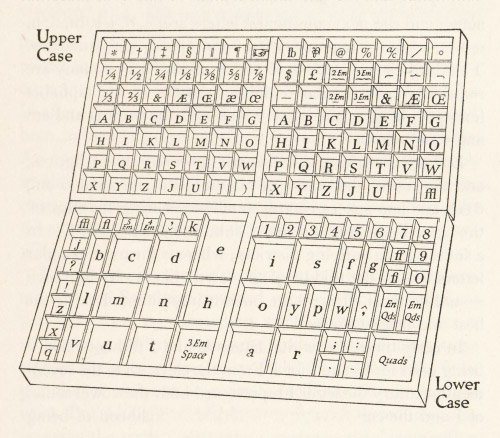 Figure 4
A Pair of Printer’s Cases
Figure 4
A Pair of Printer’s Cases
-
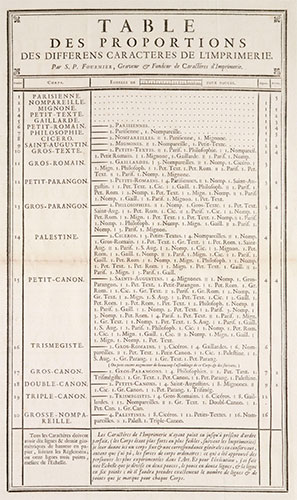 Figure 5
Fournier’s Table of Proportions of Bodies of Different Types
1742
Figure 5
Fournier’s Table of Proportions of Bodies of Different Types
1742
-
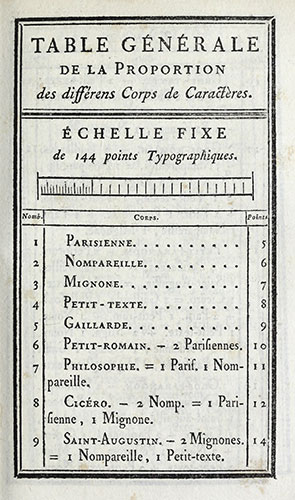 Figures 6 & 7
Fournier’s perfected Table of Proportions for his Point System
1764
Figures 6 & 7
Fournier’s perfected Table of Proportions for his Point System
1764
-
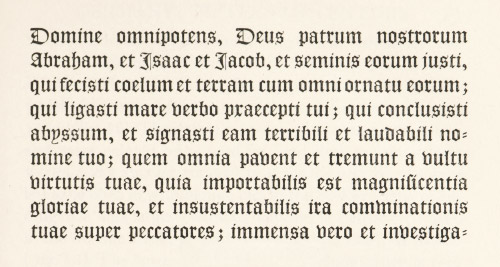 Figure 8
English lettre de forme
Figure 8
English lettre de forme
-
 Figure 9
French lettre de Somme
Figure 9
French lettre de Somme
-
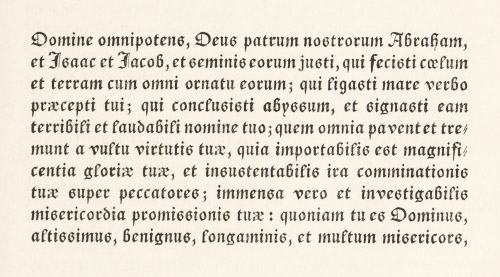 Figure 10
French lettre Batarde
Figure 10
French lettre Batarde
-
 Figure 11
Portion of 30-line Letters of Indulgence, Mainz
1455
Figure 11
Portion of 30-line Letters of Indulgence, Mainz
1455
-
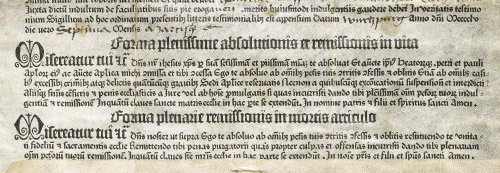 Figure 12
Portion of 31-line Letters of Indulgence, Mainz
1455
Figure 12
Portion of 31-line Letters of Indulgence, Mainz
1455
-
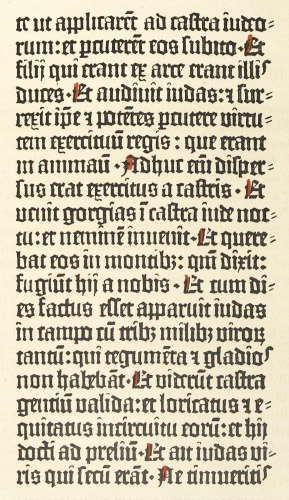 Figure 13
Type of 36-line Bible, Mainz
1461
Figure 13
Type of 36-line Bible, Mainz
1461
-
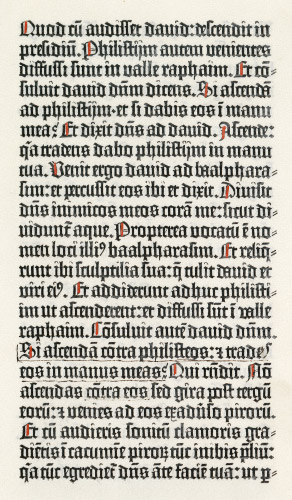 Figure 14
Type of 42-line Bible, Mainz
1455
Figure 14
Type of 42-line Bible, Mainz
1455
-
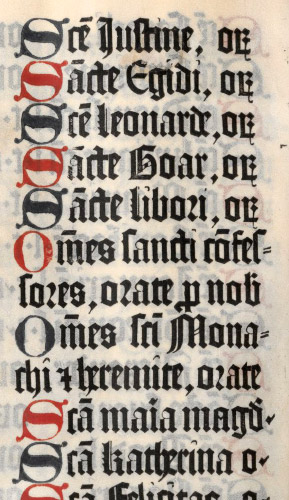 Figure 15
Type used in Latin Psalter: Fust Schoeffer, Mainz
1457
Figure 15
Type used in Latin Psalter: Fust Schoeffer, Mainz
1457
-
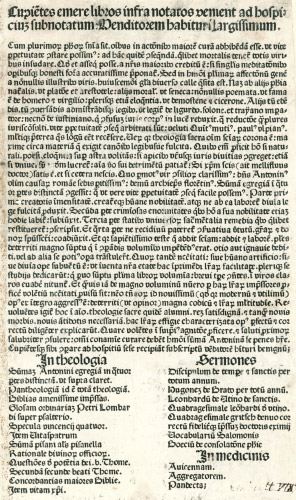 Figure 16
Advertisement issued by Koberger, Nuremberg
1480
Figure 16
Advertisement issued by Koberger, Nuremberg
1480
-
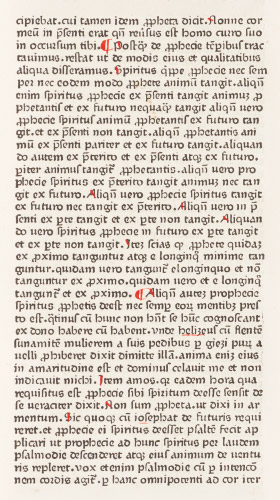 Figure 17
Round Gothic Type of Catholicon: Gutenberg
1460
Figure 17
Round Gothic Type of Catholicon: Gutenberg
1460
-
 Figure 18
Type prefiguring Schwabacher, used in Hortus Sanitatis: Peter Schoeffer, Mainz
1485
Figure 18
Type prefiguring Schwabacher, used in Hortus Sanitatis: Peter Schoeffer, Mainz
1485
-
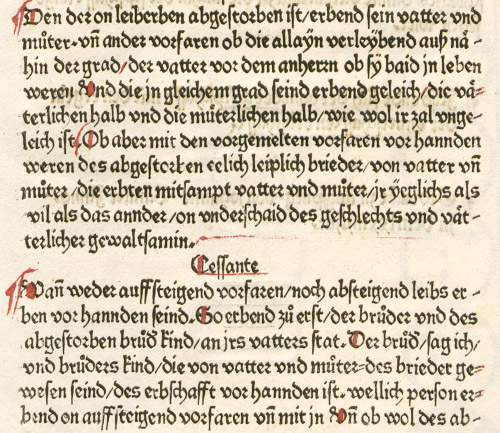 Figure 19
Pointed Gothic Type: Baemler, Augsburg
1474
Figure 19
Pointed Gothic Type: Baemler, Augsburg
1474
-
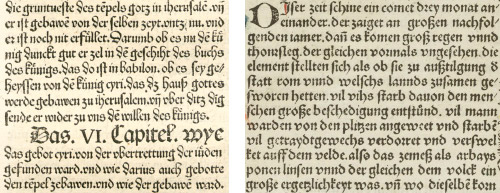 Figure 20 a & b
Gothic Types used by Koberger at Nuremberg
1483
Figure 20 a & b
Gothic Types used by Koberger at Nuremberg
1483
-
 Figure 21
Semi-Gothic Type: Mentelin, Strassburg
1460
Figure 21
Semi-Gothic Type: Mentelin, Strassburg
1460
-
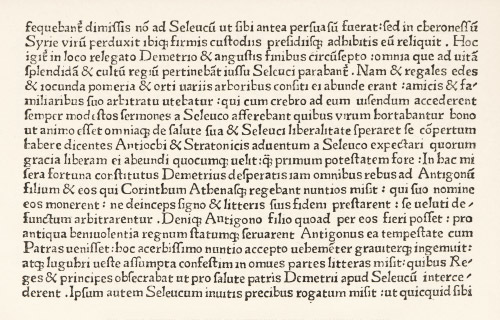 Figure 22
First Roman Type used in Germany: Rusch, Strassburg
1464
Figure 22
First Roman Type used in Germany: Rusch, Strassburg
1464
-
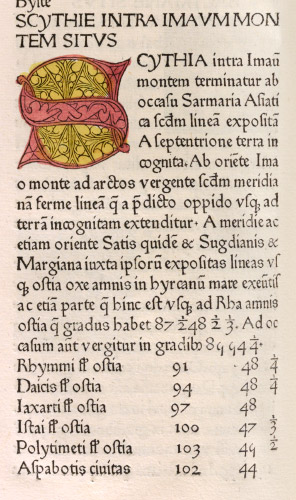 Figure 23
Transitional Roman-Gothic: Holle, Ulm
1482
Figure 23
Transitional Roman-Gothic: Holle, Ulm
1482
-
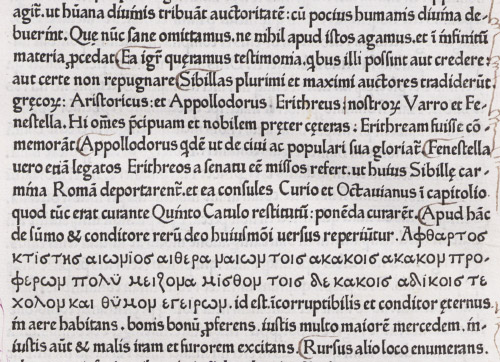 Figure 24
First Type used in Italy: Sweynheym and Pannartz, Subiaco
1465
Figure 24
First Type used in Italy: Sweynheym and Pannartz, Subiaco
1465
-
 Figure 25
Second Type of Sweynheym and Pannartz, Rome
1467
Figure 25
Second Type of Sweynheym and Pannartz, Rome
1467
-
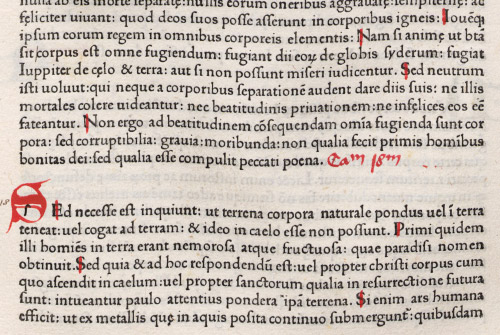 Figure 26
John and Wednelin de Spire’s Roman Type, Venice
1470
Figure 26
John and Wednelin de Spire’s Roman Type, Venice
1470
-
 Figure 27
Jenson’s Roman Type used in Eusebius, De Præparatione Evangelica, Venice
1470
Figure 27
Jenson’s Roman Type used in Eusebius, De Præparatione Evangelica, Venice
1470
-
 Figure 28
Page of Hypnerotomachia Poliphili: Aldus, Venice
1499
Figure 28
Page of Hypnerotomachia Poliphili: Aldus, Venice
1499
-
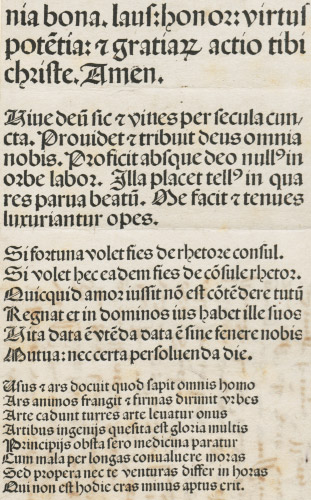 Figure 29
Ratdolt’s Gothic Type, from his Specimen
1486
Figure 29
Ratdolt’s Gothic Type, from his Specimen
1486
-
 Figure 30
Ratdolt’s Roman and Greek Type, from his Specimen
1486
Figure 30
Ratdolt’s Roman and Greek Type, from his Specimen
1486
-
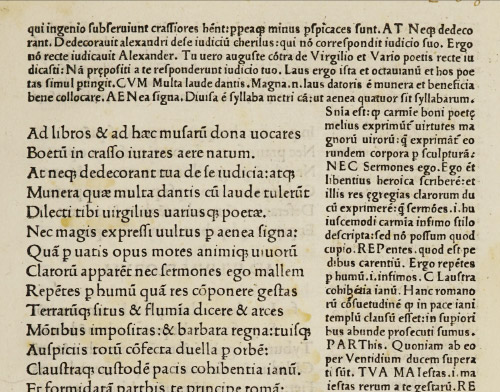 Figure 31
Part of a page of Horace: Miscomini, Florence
1482
Figure 31
Part of a page of Horace: Miscomini, Florence
1482
-
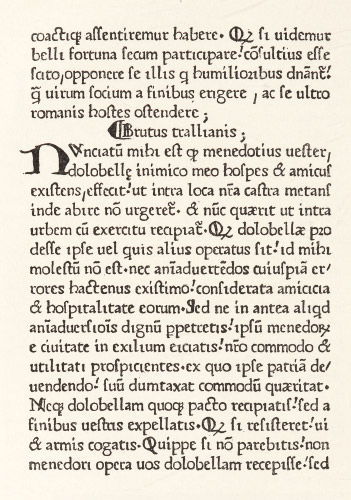 Figure 32
First Roman Type used in France: Freiburger, Gering and Kranz, Paris
1470
Figure 32
First Roman Type used in France: Freiburger, Gering and Kranz, Paris
1470
-
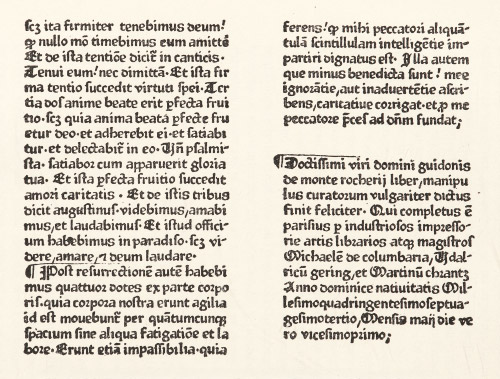 Figure 33
First Gothic Type used in France: Frieburger, Gering, and Kranz, Paris
1473
Figure 33
First Gothic Type used in France: Frieburger, Gering, and Kranz, Paris
1473
-
 Figure 34
Type used for first Bible printed in France: Frieburger, Gering, and Kranz, Paris
1476
Figure 34
Type used for first Bible printed in France: Frieburger, Gering, and Kranz, Paris
1476
-
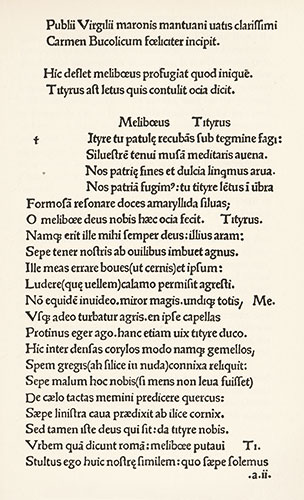 Figure 35
Roman Type used in Virgil by Gering, Paris
1478
Figure 35
Roman Type used in Virgil by Gering, Paris
1478
-
 Figure 36
Lettre Batarde used in the first book printed in French: Bonhomme, Paris
1477
Figure 36
Lettre Batarde used in the first book printed in French: Bonhomme, Paris
1477
-
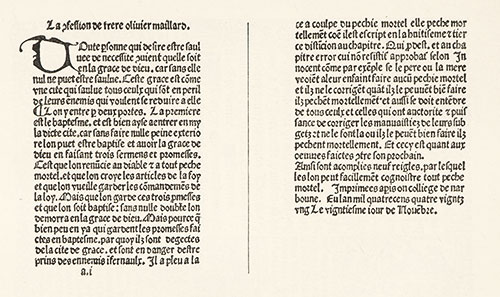 Figure 37
Condensed Gothic Type used by Bötticher, Paris
1481
Figure 37
Condensed Gothic Type used by Bötticher, Paris
1481
-
 Figure 38
Page from Book of Hours in Transitional style
1488
Figure 38
Page from Book of Hours in Transitional style
1488
-
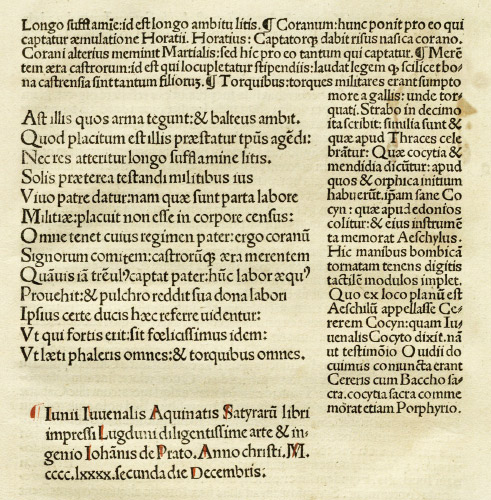 Figure 39
First Roman type used in Lyons: Du Pré
1490
Figure 39
First Roman type used in Lyons: Du Pré
1490
-
 Figure 40
Two pages of an Abecedarium
1460
Figure 40
Two pages of an Abecedarium
1460
-
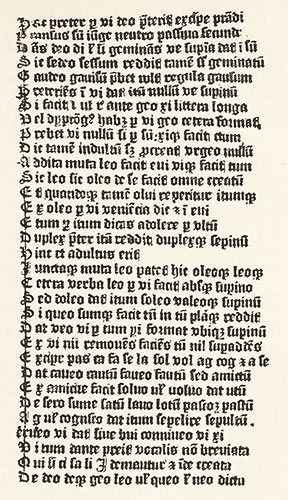 Figure 41
Gothic Type used by Printer of the Speculum
1471
Figure 41
Gothic Type used by Printer of the Speculum
1471
-
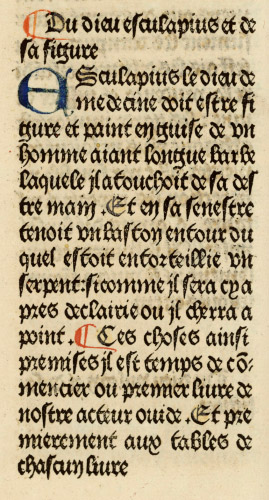 Figure 42
Mansion’s Ancienne Batarde, Bruges
1484
Figure 42
Mansion’s Ancienne Batarde, Bruges
1484
-
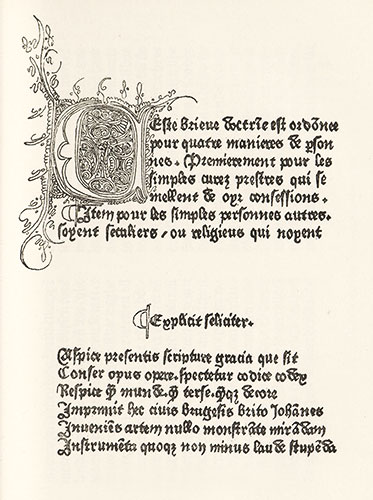 Figure 43
Lettre Batarde used by Brito, Bruges
Figure 43
Lettre Batarde used by Brito, Bruges
-
 Figure 44
Black-letter used by Bellaert, Haarlem
1485
Figure 44
Black-letter used by Bellaert, Haarlem
1485
-
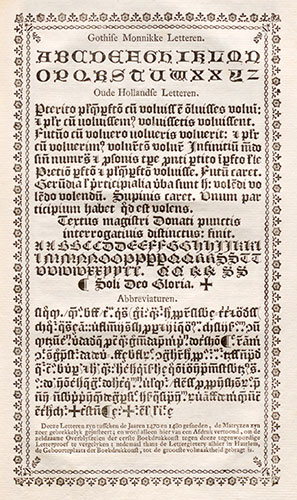 Figure 45
Fifteenth Century Saint Augustin Flamad: Enschedé’s Proef van Letteren, Haarlem, 1768
1470–1480
Figure 45
Fifteenth Century Saint Augustin Flamad: Enschedé’s Proef van Letteren, Haarlem, 1768
1470–1480
-
 Figure 46
Fifteenth Century Gros-Romain Flamand: Enschedé’s Proef van Letteren, Haarlem, 1768
1470–1480
Figure 46
Fifteenth Century Gros-Romain Flamand: Enschedé’s Proef van Letteren, Haarlem, 1768
1470–1480
-
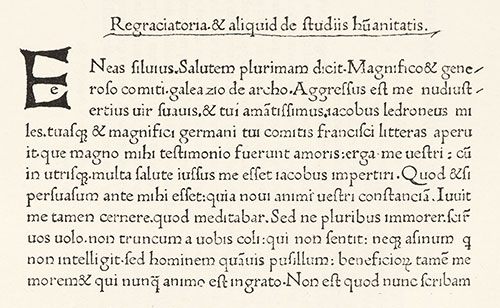 Figure 47
John of Westphalia’s Roman Type, used at Louvain
Figure 47
John of Westphalia’s Roman Type, used at Louvain
-
 Figure 48
Fifteenth Century Roman Type attributed to Schoeffer (as reconstituted by Enschedé)
1488
Figure 48
Fifteenth Century Roman Type attributed to Schoeffer (as reconstituted by Enschedé)
1488
-
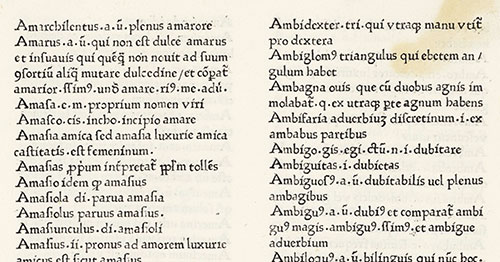 Figure 49
First Roman Type used in Spain: Palmart, Valencia
1475
Figure 49
First Roman Type used in Spain: Palmart, Valencia
1475
-
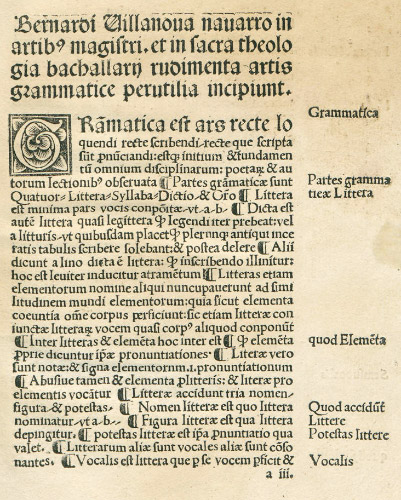 Figure 50
Spindeler’s Roman Type, Valencia
1500
Figure 50
Spindeler’s Roman Type, Valencia
1500
-
 Figure 51
Fadrique de Basilea’s Roman Type, Burgos
1499
Figure 51
Fadrique de Basilea’s Roman Type, Burgos
1499
-
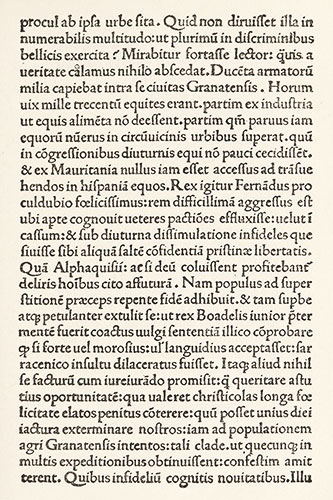 Figure 52
Roman Type used by Ungut and Stanislaus, Seville
1492
Figure 52
Roman Type used by Ungut and Stanislaus, Seville
1492
-
 Figure 53
First Gothic Type used in Spain: Palmart, Valencia
1482
Figure 53
First Gothic Type used in Spain: Palmart, Valencia
1482
-
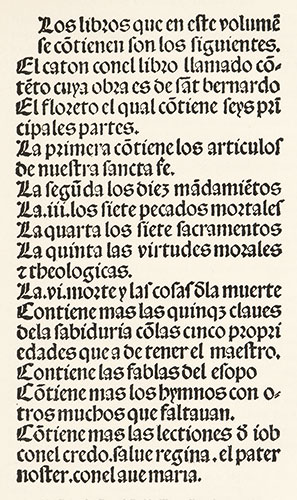 Figure 54
Brocar’s Round Gothic Type, Pamplona
1499
Figure 54
Brocar’s Round Gothic Type, Pamplona
1499
-
 Figure 55
Gothic Type used by Pablo Hurus, Saragossa
1496
Figure 55
Gothic Type used by Pablo Hurus, Saragossa
1496
-
 Figure 56
Title-page of Gordonio’s Lilio de Medicina: Ungut and Stanislaus, Seville
1495
Figure 56
Title-page of Gordonio’s Lilio de Medicina: Ungut and Stanislaus, Seville
1495
-
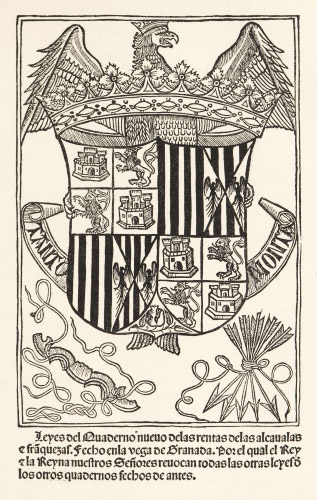 Figure 57
Title-page of Leyes del Quaderno, etc., Salamanca
1496
Figure 57
Title-page of Leyes del Quaderno, etc., Salamanca
1496
-
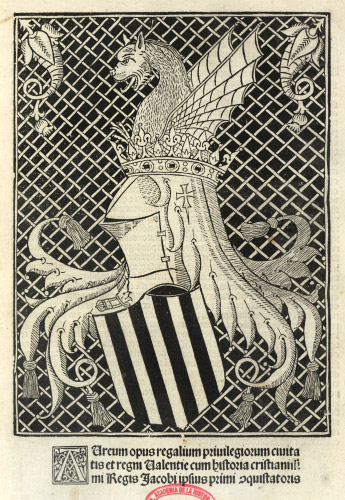 Figure 58
Title-page of Aurem Opus: Diego de Gumiel, Valencia
1515
Figure 58
Title-page of Aurem Opus: Diego de Gumiel, Valencia
1515
-
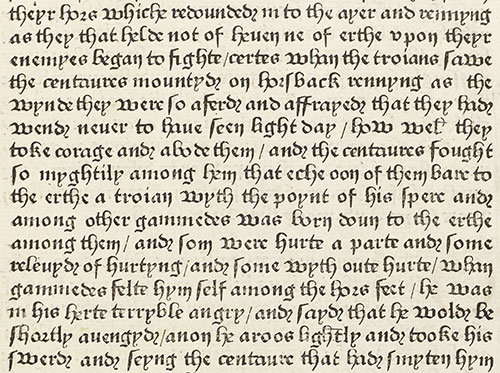 Figure 59
Caxton’s Type 1. From The Recuyell of the Historyes of Troye (first book printed in English), Caxton and Mansion, Bruges
1475
Figure 59
Caxton’s Type 1. From The Recuyell of the Historyes of Troye (first book printed in English), Caxton and Mansion, Bruges
1475
-
 Figure 60
Caxton’s Type 2. From The Dictes or Sayengis of the Philosophres, Westminster, 1477
1477
Figure 60
Caxton’s Type 2. From The Dictes or Sayengis of the Philosophres, Westminster, 1477
1477
-
 Figure 61
Caxton’s Type 3. Used in his Handbill, Westminster
1477
Figure 61
Caxton’s Type 3. Used in his Handbill, Westminster
1477
-
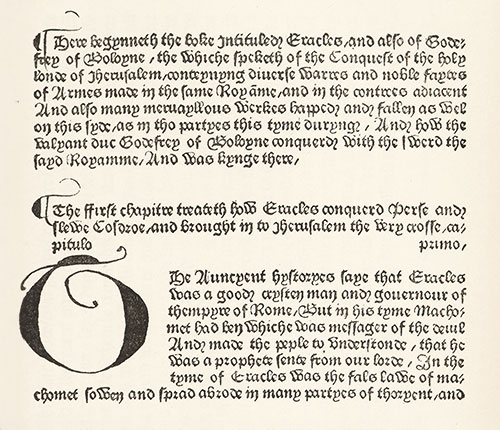 Figure 62
Caxton’s Type 4. From Godfrey of Boloyne, Westminster
1481
Figure 62
Caxton’s Type 4. From Godfrey of Boloyne, Westminster
1481
-
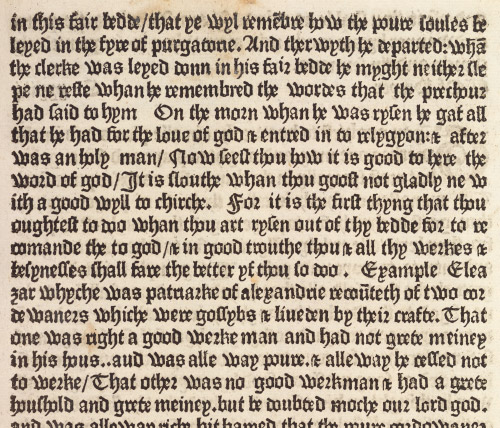 Figure 63
Caxton’s Type 5. From The Doctrinal of Sapience, Westminster
1489
Figure 63
Caxton’s Type 5. From The Doctrinal of Sapience, Westminster
1489
-
 Figure 64
Caxton’s Types 6 and 8 from Tretyse of Love, Westminster
1493
Figure 64
Caxton’s Types 6 and 8 from Tretyse of Love, Westminster
1493
-
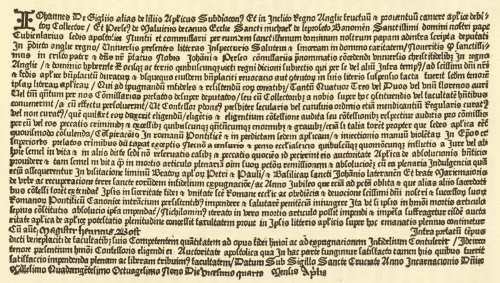 Figure 65
Caxton’s Type 7. Used in Indulgence, Westminster
1489
Figure 65
Caxton’s Type 7. Used in Indulgence, Westminster
1489
-
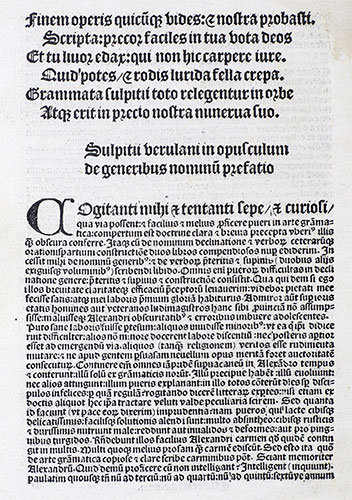 Figure 66
Gothic Types used by Wynkyn de Worde, Westminster
1499
Figure 66
Gothic Types used by Wynkyn de Worde, Westminster
1499
-
 Figure 67
Lettres de Forme used by Notary and Barbier, Westminster
1498
Figure 67
Lettres de Forme used by Notary and Barbier, Westminster
1498
-
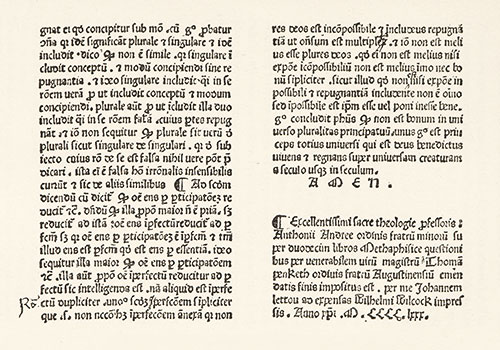 Figure 68
Transitional Gothic Type used in Andreæ Antonius, Quæstiones super Duodecim Libros Metaphysicæ Aristotelis: Lettou, London, 1480
1480
Figure 68
Transitional Gothic Type used in Andreæ Antonius, Quæstiones super Duodecim Libros Metaphysicæ Aristotelis: Lettou, London, 1480
1480
-
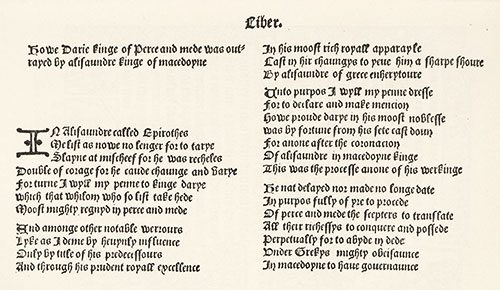 Figure 69
Lettre Batarde used in The Fall of Pinces: Pynson, London
1480
Figure 69
Lettre Batarde used in The Fall of Pinces: Pynson, London
1480
-
 Figure 70
Lettre de Forme used by Pynson, London
1495
Figure 70
Lettre de Forme used by Pynson, London
1495
-
 Figure 71
Greek Type used in Philostratus: Aldus, Venice
1501
Figure 71
Greek Type used in Philostratus: Aldus, Venice
1501
-
 Figure 72
Aldine Italic as used in Juvenal and Persius: Aldus, Venice
1501
Figure 72
Aldine Italic as used in Juvenal and Persius: Aldus, Venice
1501
-
 Figure 73
Type used in Diurnale: Schönsperger, Nuremberg
1514
Figure 73
Type used in Diurnale: Schönsperger, Nuremberg
1514
-
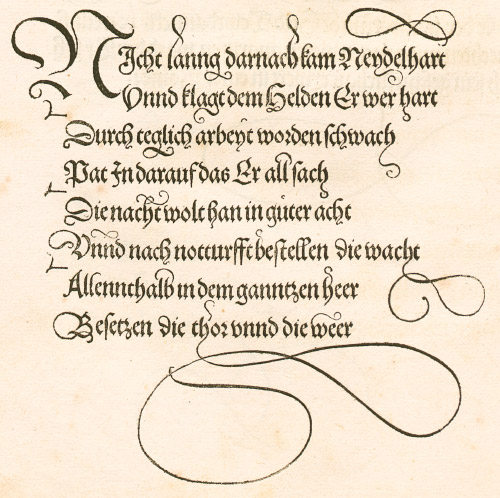 Figure 74
Type used in Teuerdanck: Schönsperger, Nuremberg
1517
Figure 74
Type used in Teuerdanck: Schönsperger, Nuremberg
1517
-
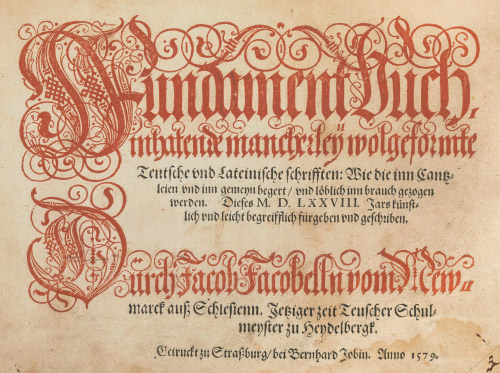 Figure 75
Title-page of Fundamentbuch: Jobin, Strassburg
1579
Figure 75
Title-page of Fundamentbuch: Jobin, Strassburg
1579
-
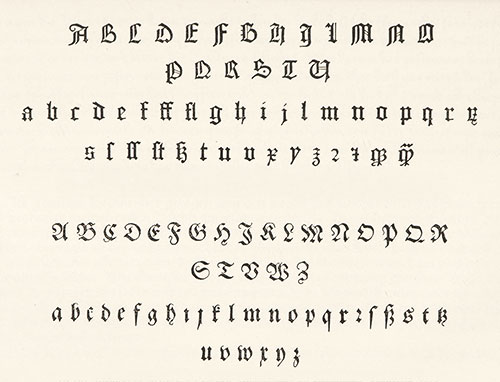 Figure 76 a & b
Alphabets of Fifteenth and Sixteenth Century Fraktur
1479 & 1566
Figure 76 a & b
Alphabets of Fifteenth and Sixteenth Century Fraktur
1479 & 1566
-
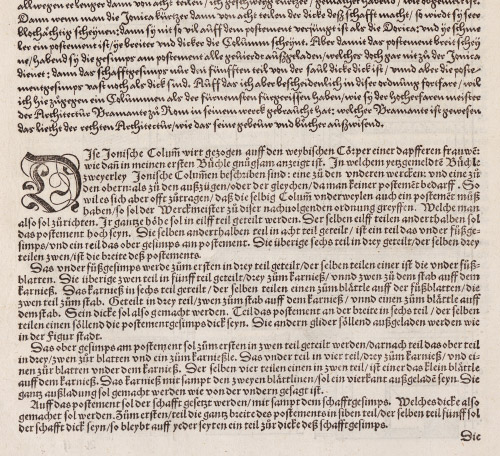 Figure 77
Cursive and Schwabacher used by Froschauer, Zurich
1567
Figure 77
Cursive and Schwabacher used by Froschauer, Zurich
1567
-
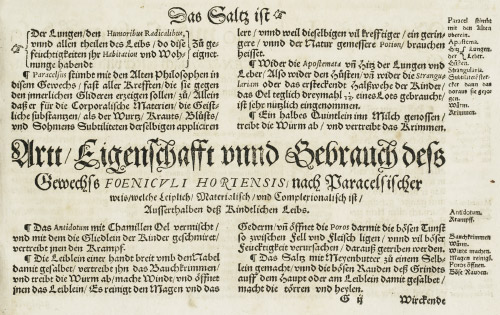 Figure 78
Types used by Hentzsken, Berlin
1578
Figure 78
Types used by Hentzsken, Berlin
1578
-
 Figure 79
Roman Type used by Schoeffer, Mainz
1520
Figure 79
Roman Type used by Schoeffer, Mainz
1520
-
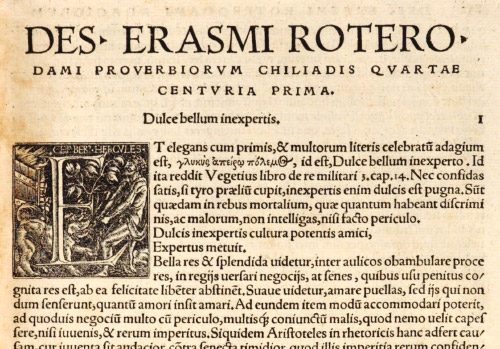 Figure 80
Roman Type used by Froben, Basle
1526
Figure 80
Roman Type used by Froben, Basle
1526
-
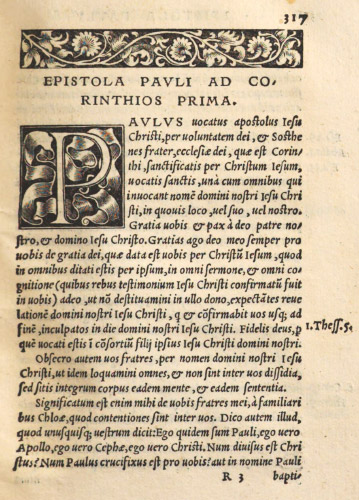 Figure 81
Italic in Erasmus’s New Testament: Froben, Basle
1521
Figure 81
Italic in Erasmus’s New Testament: Froben, Basle
1521
-
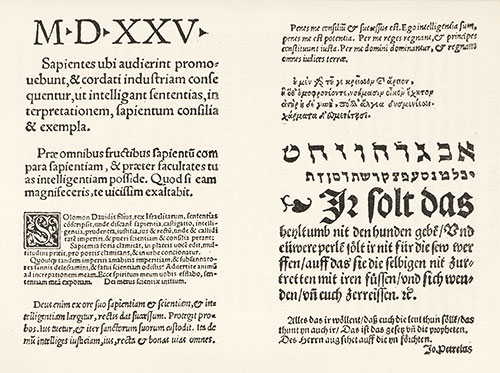 Figure 82
Specimen of J. Petri, Basle
1525
Figure 82
Specimen of J. Petri, Basle
1525
-
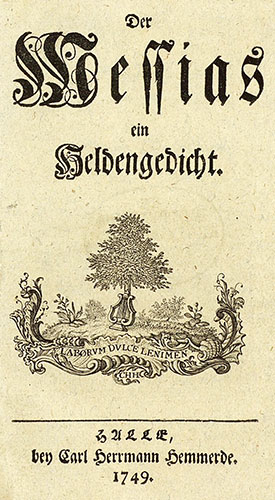 Figure 83
Title page of Klopstock’s Messias: Halle
1749
Figure 83
Title page of Klopstock’s Messias: Halle
1749
-
 Figure 84
Title-page of Winckelmann’s Kunst des Alterhums: Dresden
1764
Figure 84
Title-page of Winckelmann’s Kunst des Alterhums: Dresden
1764
-
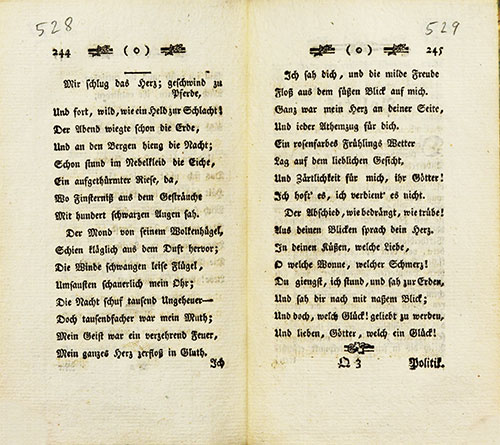 Figure 85
Pages of Jacobi’s Iris, Düsseldorf, 1775
1764
Figure 85
Pages of Jacobi’s Iris, Düsseldorf, 1775
1764
-
 Figure 86
Title-page of first edition of Faust: Goschen, Leipsic
1790
Figure 86
Title-page of first edition of Faust: Goschen, Leipsic
1790
-
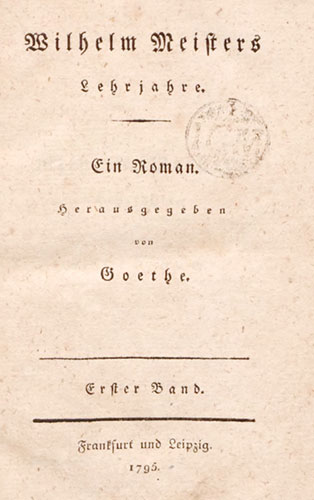 Figure 87
Title-page of Wilhelm Meister: Unger, Berlin
1795
Figure 87
Title-page of Wilhelm Meister: Unger, Berlin
1795
-
 Figure 88
Fraktur, Schwabacher, and Cursive, as shown by Fournier le jeune
1764
Figure 88
Fraktur, Schwabacher, and Cursive, as shown by Fournier le jeune
1764
-
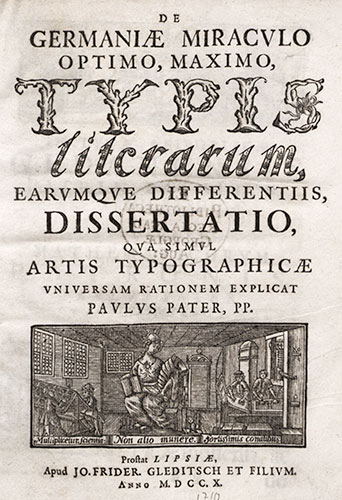 Figure 89
Title-page of Pater’s Dissertatio, Leipsic
1710
Figure 89
Title-page of Pater’s Dissertatio, Leipsic
1710
-
 Figure 90
Types from Pater’s Dissertatio, Leipsic
1710
Figure 90
Types from Pater’s Dissertatio, Leipsic
1710
-
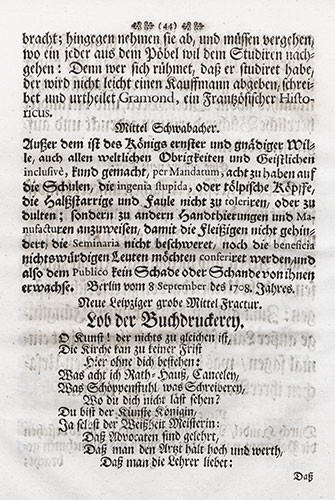 Figure 91
Fraktur and Schwabacher Types: Pater’s Dissertatio, Leipsic
1710
Figure 91
Fraktur and Schwabacher Types: Pater’s Dissertatio, Leipsic
1710
-
 Figure 92
Typographical Ornaments, probably from the Endters Printing-house, Nuremberg
1721
Figure 92
Typographical Ornaments, probably from the Endters Printing-house, Nuremberg
1721
-
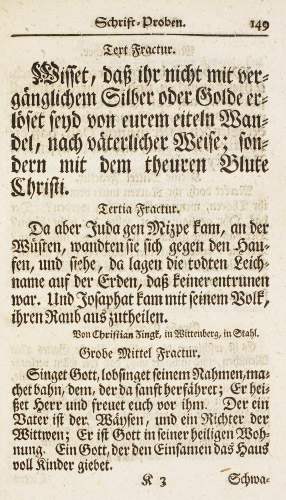 Figure 93
Fraktur Types of Breitkopf’s Schrift-Probe, Leipsic
1739
Figure 93
Fraktur Types of Breitkopf’s Schrift-Probe, Leipsic
1739
-
 Figure 94
Roman and Italic Types: Breitkopf’s Schrift-Probe, Leipsic
1739
Figure 94
Roman and Italic Types: Breitkopf’s Schrift-Probe, Leipsic
1739
-
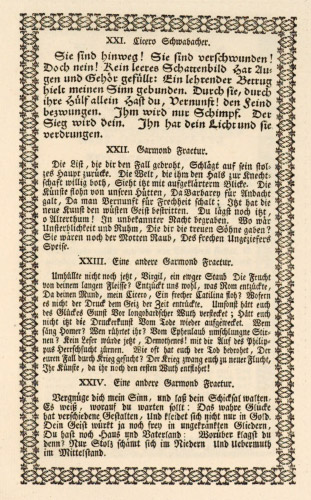 Figure 95
Schwabacher and Fraktur: Trattner’s Abdruck dererjenigen Deutschen Schriften, etc., Vienna
1760
Figure 95
Schwabacher and Fraktur: Trattner’s Abdruck dererjenigen Deutschen Schriften, etc., Vienna
1760
-
 Figure 96
Ornaments: Trattner’s Abdruck von denjenigen Röslein, etc., Vienna
1760
Figure 96
Ornaments: Trattner’s Abdruck von denjenigen Röslein, etc., Vienna
1760
-
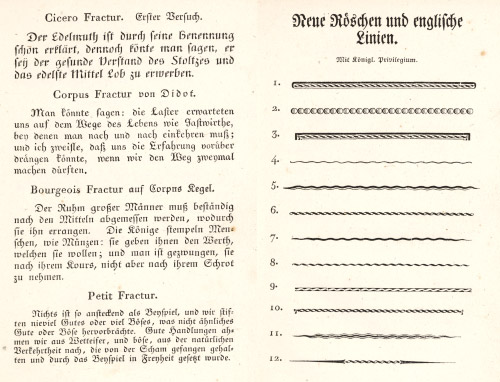 Figure 97 a & b
Neue Deutsche Lettern and Ornaments: Unger’s Schriftproben, Berlin
1791
Figure 97 a & b
Neue Deutsche Lettern and Ornaments: Unger’s Schriftproben, Berlin
1791
-
 Figure 98
Unger’s and Didot’s Modifications of German Fraktur
1793
Figure 98
Unger’s and Didot’s Modifications of German Fraktur
1793
-
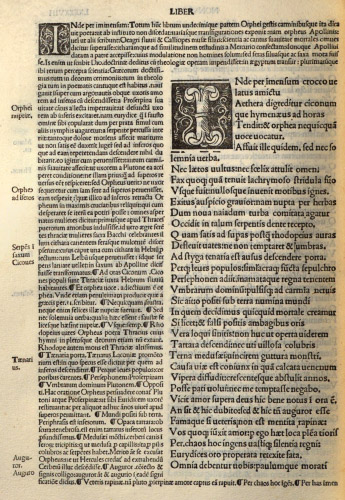 Figure 99
Page of Ovid: Gorgonzola, Milan
1509
Figure 99
Page of Ovid: Gorgonzola, Milan
1509
-
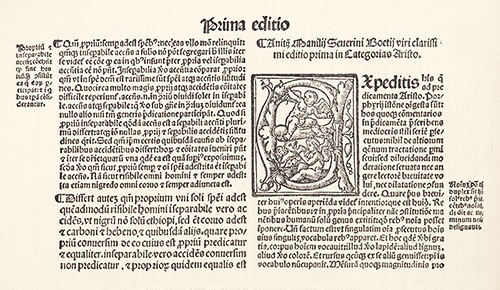 Figure 100
Gothic Type in Opera of Boethius: Giunta, Venice
1536
Figure 100
Gothic Type in Opera of Boethius: Giunta, Venice
1536
-
 Figure 101
Italic in Dante’s Commedia: Marcolini, Venice
1544
Figure 101
Italic in Dante’s Commedia: Marcolini, Venice
1544
-
 Figure 102
Opening of Paolo Giovio’s Historiarum sui Temporis: Torrentino, Florence
1550
Figure 102
Opening of Paolo Giovio’s Historiarum sui Temporis: Torrentino, Florence
1550
-
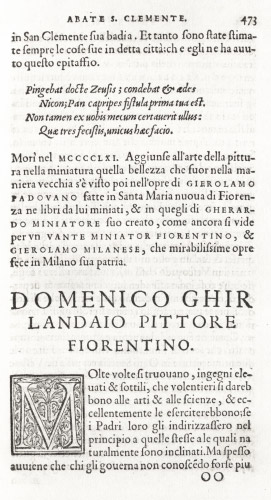 Figure 103
Types of Vasari’s Vite: Torrentino, Florence
1550
Figure 103
Types of Vasari’s Vite: Torrentino, Florence
1550
-
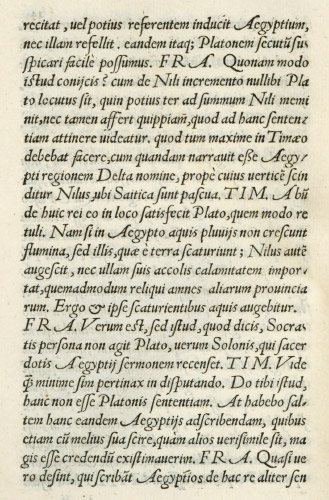 Figure 104
Italic used in Nogarola’s Dialogus, Gryphius, Venice
1552
Figure 104
Italic used in Nogarola’s Dialogus, Gryphius, Venice
1552
-
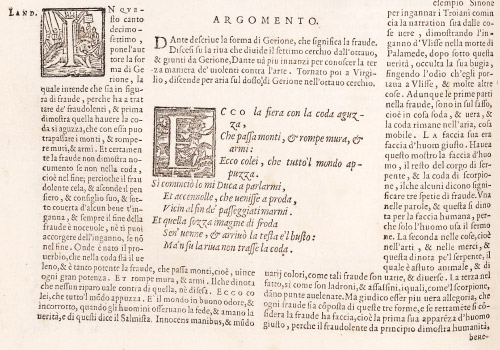 Figure 105
Types in Dante: Sessa, Venice
1564
Figure 105
Types in Dante: Sessa, Venice
1564
-
 Figure 106
Page from Decamerone: Giunta, Florence
1573
Figure 106
Page from Decamerone: Giunta, Florence
1573
-
 Figure 107
Italic in Nannini’s Considerationi Civili, Venice
1582
Figure 107
Italic in Nannini’s Considerationi Civili, Venice
1582
-
 Figure 108
Roman types of Morosoini’s Historia Veneta: Pinelli, Venice
1623
Figure 108
Roman types of Morosoini’s Historia Veneta: Pinelli, Venice
1623
-
 Figure 109
Address to the Reader: Stamperia Vaticana Specimen, Rome
1628
Figure 109
Address to the Reader: Stamperia Vaticana Specimen, Rome
1628
-
 Figure 110
Canon Grosso: Stamperia Vaticana Specimen, Rome
1628
Figure 110
Canon Grosso: Stamperia Vaticana Specimen, Rome
1628
-
 Figure 111
Ascendonica: Stamperia Vaticana Specimen, Rome
1628
Figure 111
Ascendonica: Stamperia Vaticana Specimen, Rome
1628
-
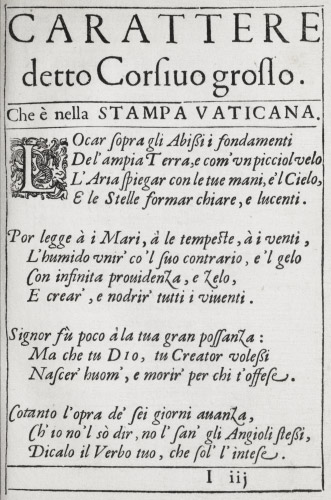 Figure 112
Corsivo Grosso: Stamperia Vaticana Specimen, Rome
1628
Figure 112
Corsivo Grosso: Stamperia Vaticana Specimen, Rome
1628
-
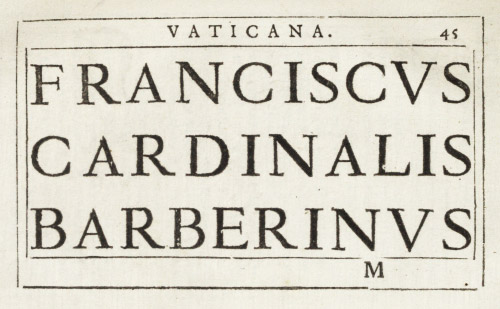 Figure 113
Roman Capitals: Stamperia Vaticana Specimen, Rome
1628
Figure 113
Roman Capitals: Stamperia Vaticana Specimen, Rome
1628
-
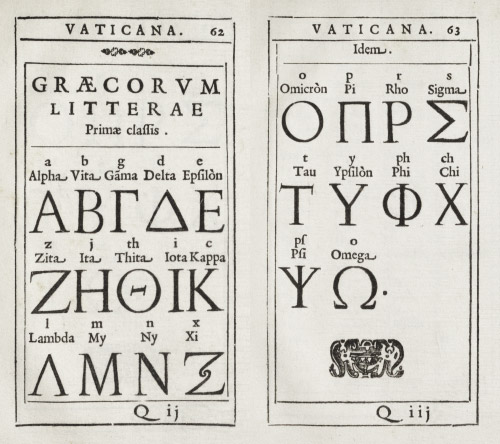 Figure 114
Alphabet of Greek Capitals: Stamperia Vaticana Specimen, Rome
1628
Figure 114
Alphabet of Greek Capitals: Stamperia Vaticana Specimen, Rome
1628
-
 Figures 115 & 116
Plain-Song: Stamperia Vaticana Specimen, Rome
1628
Figures 115 & 116
Plain-Song: Stamperia Vaticana Specimen, Rome
1628
-
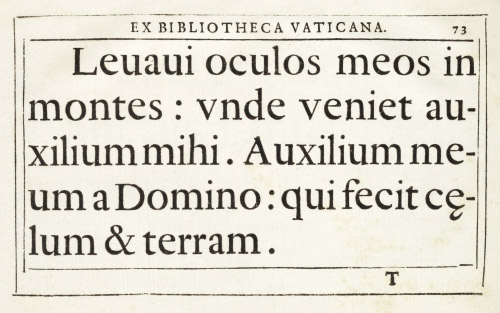 Figure 117
Type used for Missals: Stamperia Vaticana Specimen, Rome
1628
Figure 117
Type used for Missals: Stamperia Vaticana Specimen, Rome
1628
-
 Figure 118
Page from La Clori: Pignoni, Florence
1626
Figure 118
Page from La Clori: Pignoni, Florence
1626
-
 Figure 119
Roman and Italic Types showing “modern” tendency, used in Magalotti’s Saggi di Naturali Esperienze, etc.: Cecchi, Florence
1691
Figure 119
Roman and Italic Types showing “modern” tendency, used in Magalotti’s Saggi di Naturali Esperienze, etc.: Cecchi, Florence
1691
-
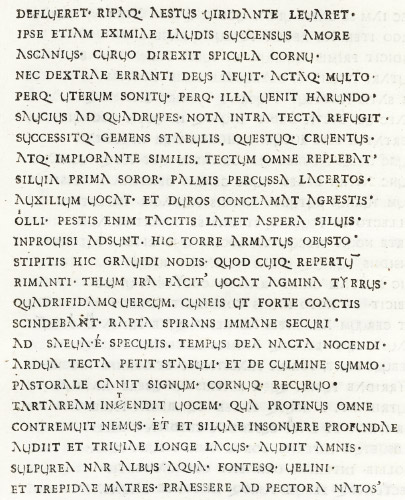 Figure 120
Type imitating ancient Manuscript, used in Virgil: Manni, Florence
1741
Figure 120
Type imitating ancient Manuscript, used in Virgil: Manni, Florence
1741
-
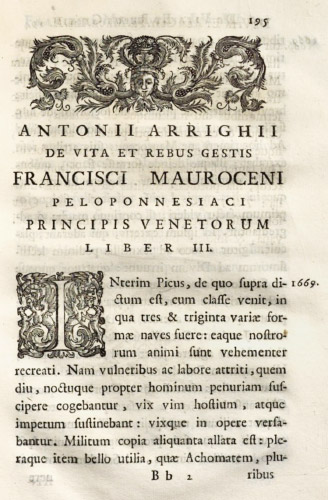 Figure 121
Types of Arrighi’s Life of Morosini: Comino, Padua
1749
Figure 121
Types of Arrighi’s Life of Morosini: Comino, Padua
1749
-
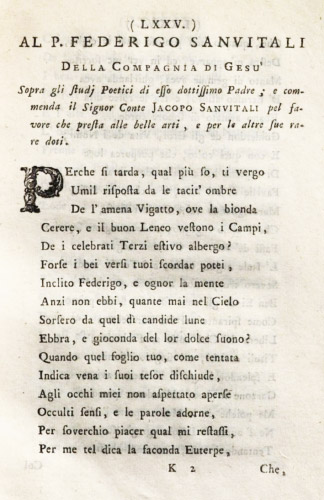 Figure 122
Page showing light types, openly set, in Versi Sciolti di Tre Eccellenti Moderni Autori: Fenzo, Venice
1759
Figure 122
Page showing light types, openly set, in Versi Sciolti di Tre Eccellenti Moderni Autori: Fenzo, Venice
1759
-
 Figure 123
Italic in Dedication of Gerusalemme Liberata: Albrizzi, Venice
1745
Figure 123
Italic in Dedication of Gerusalemme Liberata: Albrizzi, Venice
1745
-
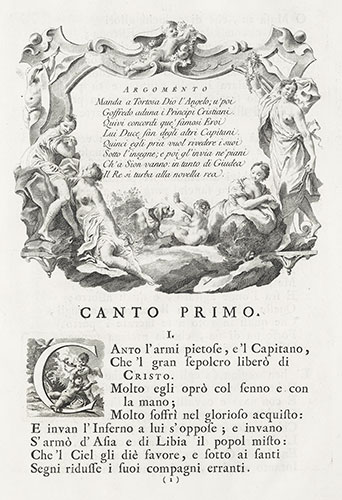 Figure 124
Page of Gerusalemme Liberata: Albrizzi, Venice
1745
Figure 124
Page of Gerusalemme Liberata: Albrizzi, Venice
1745
-
 Figure 125
Pages from Gerusalemme Liberata: Zatta, Venice
1787
Figure 125
Pages from Gerusalemme Liberata: Zatta, Venice
1787
-
 Figure 126
Types showing “modern” feeling, used in Sardini’s Storia Critia di Nicolao Jenson: Bonsignori, Lucca
1796
Figure 126
Types showing “modern” feeling, used in Sardini’s Storia Critia di Nicolao Jenson: Bonsignori, Lucca
1796
-
 Figure 127
Types showing “modern” feeling, used in Poggiali’s Storia Letteraria di Piacenza: Orcesi, Piacenza
1789
Figure 127
Types showing “modern” feeling, used in Poggiali’s Storia Letteraria di Piacenza: Orcesi, Piacenza
1789
-
 Figure 128
Testo and Palestina from Bodoni’s Fregi e Majuscole, Parma
1771
Figure 128
Testo and Palestina from Bodoni’s Fregi e Majuscole, Parma
1771
-
 Figure 129
Ornaments from Bodoni’s Fregi e Majuscole, Parma
1771
Figure 129
Ornaments from Bodoni’s Fregi e Majuscole, Parma
1771
-
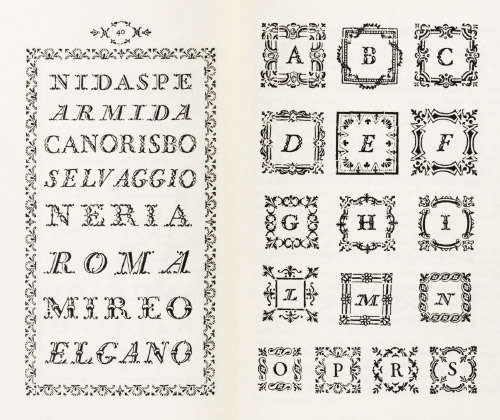 Figure 130 a & b
Ornamented Letters and Initials from Bodoni’s Fregi e Majuscole, Parma
1771
Figure 130 a & b
Ornamented Letters and Initials from Bodoni’s Fregi e Majuscole, Parma
1771
-
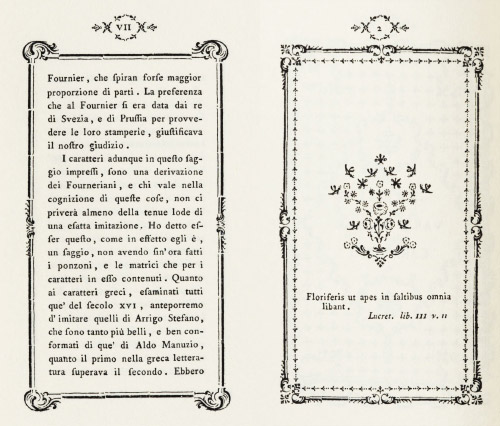 Figure 131 a & b
Page from Saggio Tipografico and Reverse of half-title of Fregi. Bodoni’s Fregi e Majuscole, Parma
1771
Figure 131 a & b
Page from Saggio Tipografico and Reverse of half-title of Fregi. Bodoni’s Fregi e Majuscole, Parma
1771
-
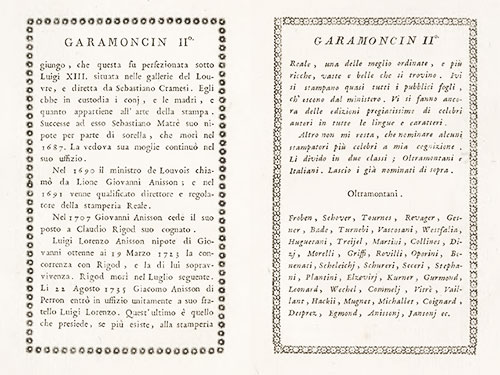 Figure 132
Types from Zatta’s Saggi dei Caratteri, Venice
1794
Figure 132
Types from Zatta’s Saggi dei Caratteri, Venice
1794
-
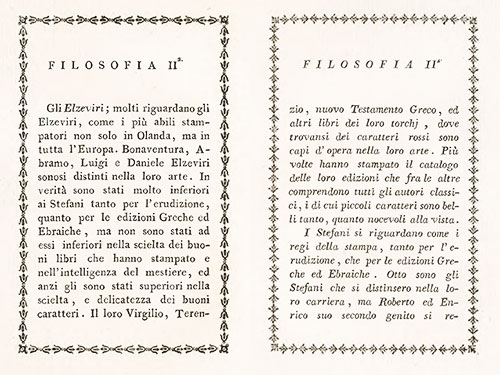 Figure 133
“Modern” Types from Zatta’s Saggi dei Caratteri, Venice
1794
Figure 133
“Modern” Types from Zatta’s Saggi dei Caratteri, Venice
1794
-
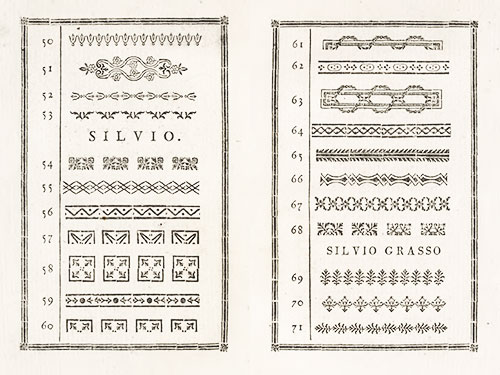 Figure 134
Borders from Zatta’s Saggi dei Caratteri, Venice
1794
Figure 134
Borders from Zatta’s Saggi dei Caratteri, Venice
1794
-
 Figure 135
Lettres de Forme, Lettres de Somme, and Ancienne Batarde shown by Fournier le jeune
1764
Figure 135
Lettres de Forme, Lettres de Somme, and Ancienne Batarde shown by Fournier le jeune
1764
-
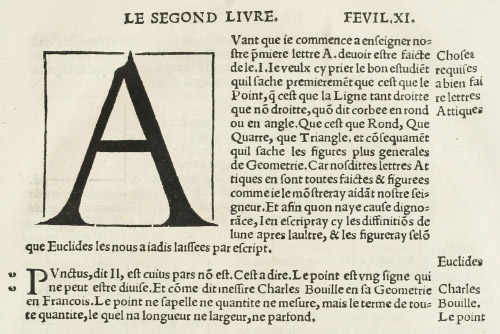 Figure 136
Portion of page from Tory’s Champfleury: Paris
1529
Figure 136
Portion of page from Tory’s Champfleury: Paris
1529
-
 Figure 137
Music Types combined with Lettre de Forme, used by Attaingnant, Paris
1532
Figure 137
Music Types combined with Lettre de Forme, used by Attaingnant, Paris
1532
-
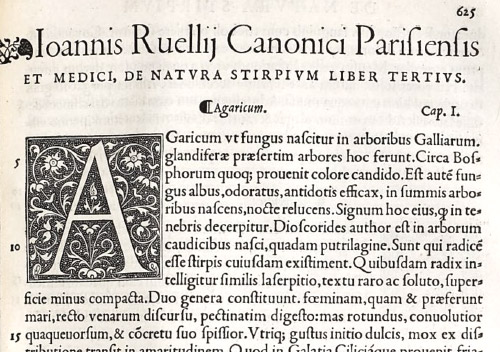 Figure 138
Roman of Ruel’s De Natura Stirpium: De Clines, Paris
1536
Figure 138
Roman of Ruel’s De Natura Stirpium: De Clines, Paris
1536
-
 Figure 139
Italic of Preface of Ruel’s De Natura Stirpium: De Clines, Paris
1536
Figure 139
Italic of Preface of Ruel’s De Natura Stirpium: De Clines, Paris
1536
-
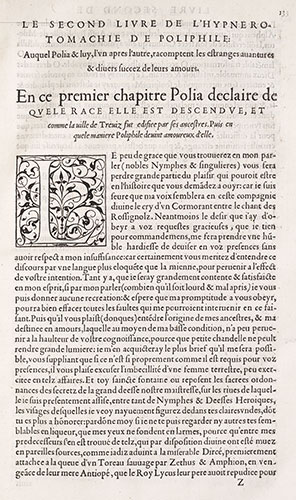 Figure 140
Page of Songe de Poliphile: Kerver, Paris
1546
Figure 140
Page of Songe de Poliphile: Kerver, Paris
1546
-
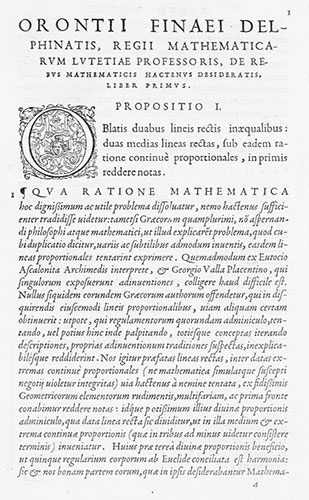 Figure 141
Types used by Vascosan, Paris
1556
Figure 141
Types used by Vascosan, Paris
1556
-
 Figure 142
Granjon’s Civilité: Breton, Paris
1559
Figure 142
Granjon’s Civilité: Breton, Paris
1559
-
 Figure 143
Old Civilité from Lamesle’s Épreuves Générales des Caractères, Paris
1742
Figure 143
Old Civilité from Lamesle’s Épreuves Générales des Caractères, Paris
1742
-
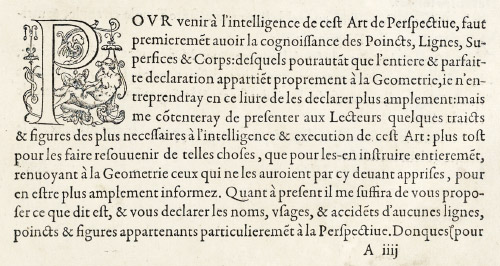 Figure 144
Roman of Caousin’s Livre de Perspective: Le Royer, Paris
1560
Figure 144
Roman of Caousin’s Livre de Perspective: Le Royer, Paris
1560
-
 Figure 145
Italic in Cousin’s Livre de Perspective: Le Royer, Paris
1560
Figure 145
Italic in Cousin’s Livre de Perspective: Le Royer, Paris
1560
-
 Figure 146
Robert Granjon’s Italic used in La Vita et Metamorfosio d’Ovidio: De Tournes, Lyons
1584
Figure 146
Robert Granjon’s Italic used in La Vita et Metamorfosio d’Ovidio: De Tournes, Lyons
1584
-
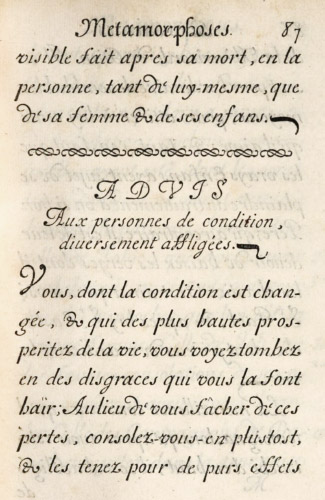 Figure 147
Moreau’s Calligraphic Types used in Les Saintes Metamorphoses, Paris
1644
Figure 147
Moreau’s Calligraphic Types used in Les Saintes Metamorphoses, Paris
1644
-
 Figure 148
Old Italics from Sanlecque’s Épreuves des Caractères, Paris
1757
Figure 148
Old Italics from Sanlecque’s Épreuves des Caractères, Paris
1757
-
 Figure 149
Old Italics from Sanlecque’s Épreuves des Caractères, Paris
1757
Figure 149
Old Italics from Sanlecque’s Épreuves des Caractères, Paris
1757
-
 Figure 150
Old Music Types, from Sanlecque’s Épreuves des Caractères, Paris
1757
Figure 150
Old Music Types, from Sanlecque’s Épreuves des Caractères, Paris
1757
-
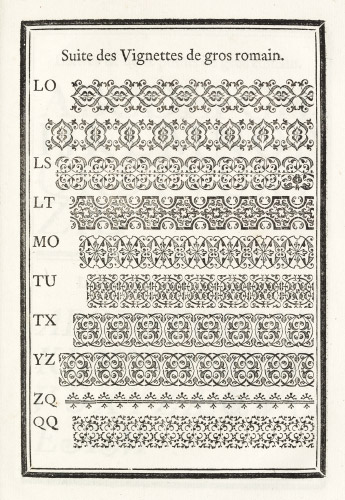 Figure 151
Seventeenth Century Ornaments from Lamesle’s Épreuves Générales des Caractères
1757
Figure 151
Seventeenth Century Ornaments from Lamesle’s Épreuves Générales des Caractères
1757
-
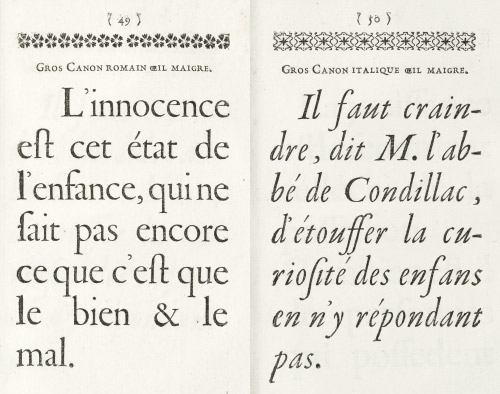 Figure 152
Early Types (œil maigre): Delacolonge’s Caractères et Vignettes, Lyons
1773
Figure 152
Early Types (œil maigre): Delacolonge’s Caractères et Vignettes, Lyons
1773
-
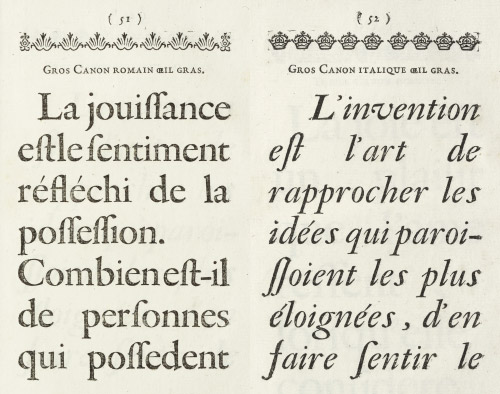 Figure 153
Early Types (œil gras): Delacolonge’s Caractères et Vignettes, Lyons
1773
Figure 153
Early Types (œil gras): Delacolonge’s Caractères et Vignettes, Lyons
1773
-
 Figure 154
Old Style Types used by Coignard, Paris
1719
Figure 154
Old Style Types used by Coignard, Paris
1719
-
 Figure 155
Fournier le jeune’s Types: Didot, Paris
1743
Figure 155
Fournier le jeune’s Types: Didot, Paris
1743
-
 Figure 156
Fournier le jeune’s Types and Ornaments, Barbou, Paris
1759
Figure 156
Fournier le jeune’s Types and Ornaments, Barbou, Paris
1759
-
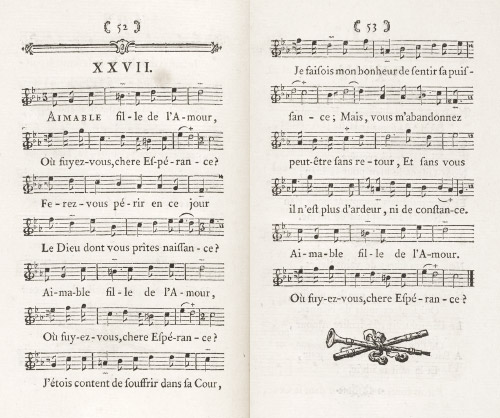 Figure 157
Fournier le jeune’s Music Types: Barbou, Paris
1765
Figure 157
Fournier le jeune’s Music Types: Barbou, Paris
1765
-
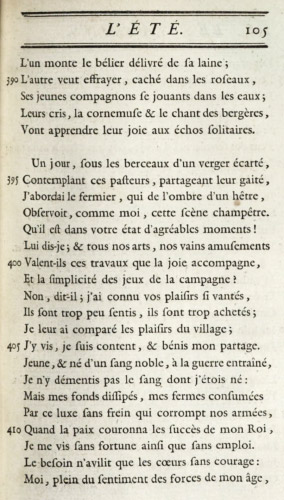 Figure 158
Roman Type in Saint Lambert’s Saisons, Paris
1775
Figure 158
Roman Type in Saint Lambert’s Saisons, Paris
1775
-
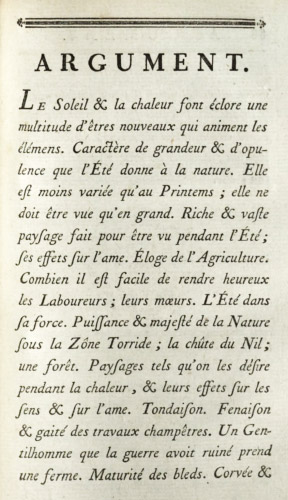 Figure 159
Italic in Saint Lambert’s Saisons, Paris
1775
Figure 159
Italic in Saint Lambert’s Saisons, Paris
1775
-
 Figure 160
Roman Types used in Géorgiques de Virgile: Didot l’aîné, Paris
1782
Figure 160
Roman Types used in Géorgiques de Virgile: Didot l’aîné, Paris
1782
-
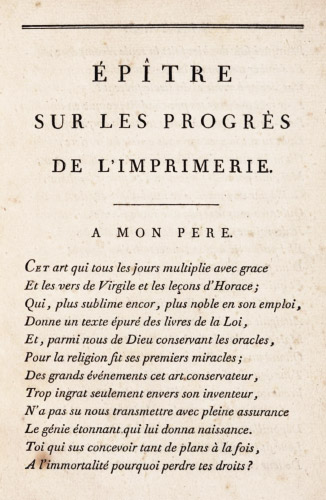 Figure 161
Page employing Firmin Didot’s Italic Type, from Didot’s Épître sur les Progrè de l’Imrimerie, printed by F. A. Didot, Paris
1784
Figure 161
Page employing Firmin Didot’s Italic Type, from Didot’s Épître sur les Progrè de l’Imrimerie, printed by F. A. Didot, Paris
1784
-
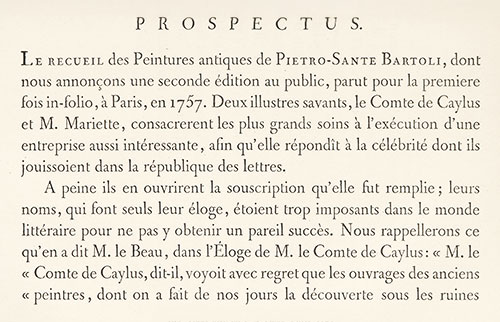 Figure 162
Types used by F. A. Didot in Prospectus of Peintures Antiques, Paris
1782
Figure 162
Types used by F. A. Didot in Prospectus of Peintures Antiques, Paris
1782
-
 Figure 163
Caractère Maigre used in Œuvres de Fénelon: F. A. and P. Didot, Paris
1787–92
Figure 163
Caractère Maigre used in Œuvres de Fénelon: F. A. and P. Didot, Paris
1787–92
-
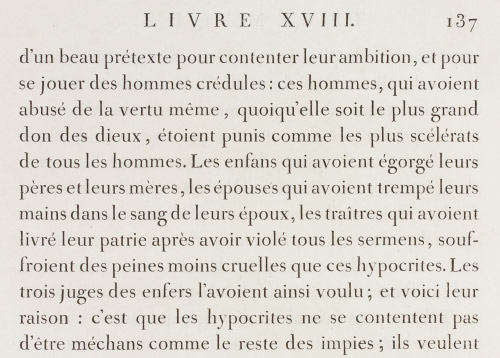 Figure 164
Caractère Gras used in Aventures de Télémaque: Pierre François Didot, Paris
1787
Figure 164
Caractère Gras used in Aventures de Télémaque: Pierre François Didot, Paris
1787
-
 Figure 165
Baskerville’s Types used in Voltaire’s La Pucelle, Kehl
1789
Figure 165
Baskerville’s Types used in Voltaire’s La Pucelle, Kehl
1789
-
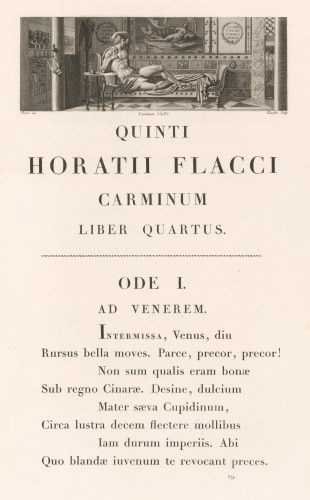 Figures 166 & 167
Page and Types of folio Horace: Pierre Didot, Paris
1799
Figures 166 & 167
Page and Types of folio Horace: Pierre Didot, Paris
1799
-
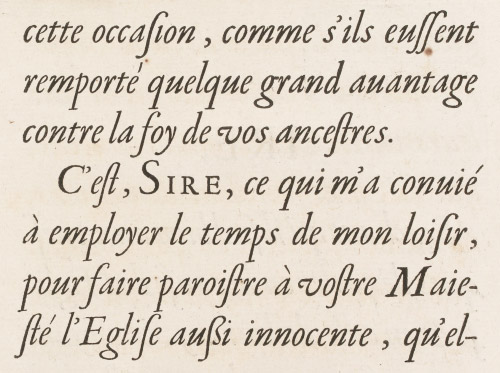 Figure 168
Garamond’s Caractères de l’Université, c. 1540, used in Richelieu’s Les Principaux Poincts de la Foy Catholique Défendus: Imprimerie royale, Paris
1642
Figure 168
Garamond’s Caractères de l’Université, c. 1540, used in Richelieu’s Les Principaux Poincts de la Foy Catholique Défendus: Imprimerie royale, Paris
1642
-
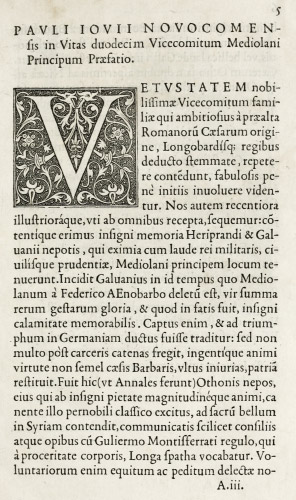 Figure 169
Roman Type (Garamond?) used in Giovio’s Vitæ: Estienne, Paris
1549
Figure 169
Roman Type (Garamond?) used in Giovio’s Vitæ: Estienne, Paris
1549
-
 Figure 170
Garamond’s Grecs du Roi (three sizes) used in Greek edition of Appiani Alexandrini Romanarum Historiarum: Estienne, Paris
1551
Figure 170
Garamond’s Grecs du Roi (three sizes) used in Greek edition of Appiani Alexandrini Romanarum Historiarum: Estienne, Paris
1551
-
 Figure 171
Page of Grec du Roi from Greek edition of Appiani Alexandrini Romanarum Historiarum: Estienne, Paris
1551
Figure 171
Page of Grec du Roi from Greek edition of Appiani Alexandrini Romanarum Historiarum: Estienne, Paris
1551
-
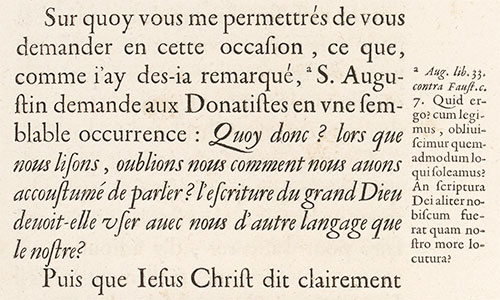 Figure 172
Garamond’s Roman and Italic Types used in Richelieu’s Les Principaux Poincts de la Foy Catholique Défendus: Imprimerie Royale, Paris
1642
Figure 172
Garamond’s Roman and Italic Types used in Richelieu’s Les Principaux Poincts de la Foy Catholique Défendus: Imprimerie Royale, Paris
1642
-
 Figure 173
Grandjean’s Romain du Roi used in Médailles sur les Principaux Événements du Règne de Louis le Grand: Imprimerie Royale, Paris
1702
Figure 173
Grandjean’s Romain du Roi used in Médailles sur les Principaux Événements du Règne de Louis le Grand: Imprimerie Royale, Paris
1702
-
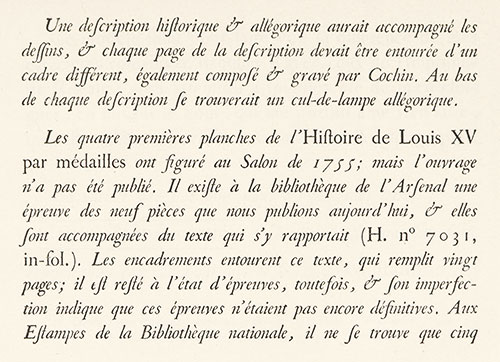 Figure 174
Grandjean’s Romain du Roi (italic) used in Cuivres de Cochin destinés à l’Histoire de Louis XV par Médailles: Imprimerie Nationale, Paris
1889
Figure 174
Grandjean’s Romain du Roi (italic) used in Cuivres de Cochin destinés à l’Histoire de Louis XV par Médailles: Imprimerie Nationale, Paris
1889
-
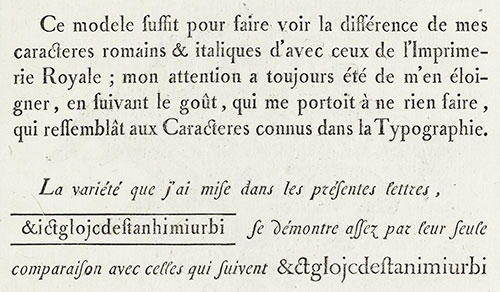 Figure 175
Luce’s Types Poétiques compared with Old Style types of Imprimerie Royale
1771
Figure 175
Luce’s Types Poétiques compared with Old Style types of Imprimerie Royale
1771
-
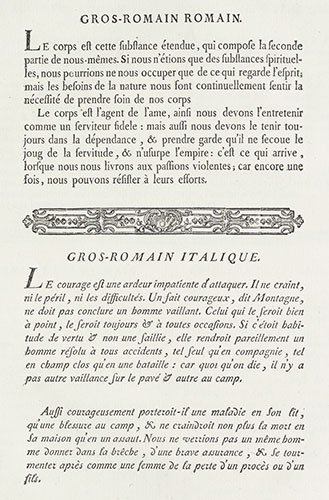 Figure 176
Luce’s Types Poétiques (roman and two versions of italic)
1771
Figure 176
Luce’s Types Poétiques (roman and two versions of italic)
1771
-
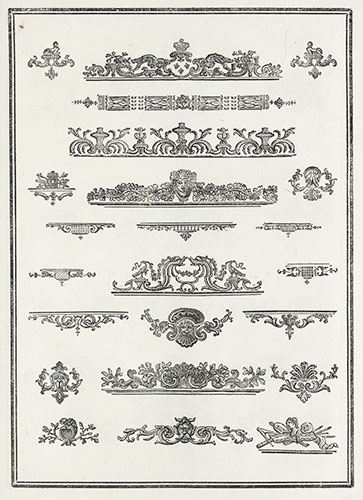 Figure 177
Luce’s Ornaments
1771
Figure 177
Luce’s Ornaments
1771
-
 Figure 178
Luce’s Employment of his Types and Ornaments
1771
Figure 178
Luce’s Employment of his Types and Ornaments
1771
-
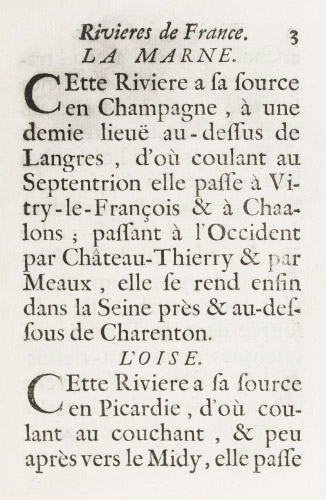 Figure 179
Page of Course de principaux Fleuves et Rivières de l’Europe, composed and printed by Louis XV when a Child: Paris
1718
Figure 179
Page of Course de principaux Fleuves et Rivières de l’Europe, composed and printed by Louis XV when a Child: Paris
1718
-
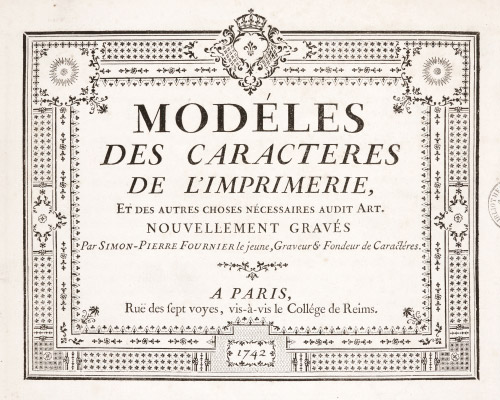 Figure 180
Title-page of Fournier le jeune’s Modèles des Caractères, Paris
1742
Figure 180
Title-page of Fournier le jeune’s Modèles des Caractères, Paris
1742
-
 Figure 181
Roman and Italic from Fournier le jeune’s Modèles des Caractè, Paris
1742
Figure 181
Roman and Italic from Fournier le jeune’s Modèles des Caractè, Paris
1742
-
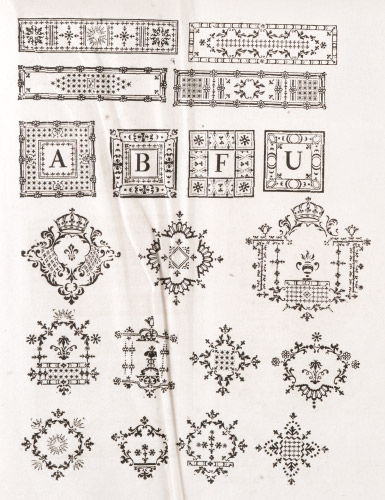 Figure 182
Use of Typographical Ornaments in Fournier le jeune’s Modèles des Caractères, Paris
1742
Figure 182
Use of Typographical Ornaments in Fournier le jeune’s Modèles des Caractères, Paris
1742
-
 Figure 183
Fournier le jeune’s Types Poétiques (cicéro, romain and italic)
1764
Figure 183
Fournier le jeune’s Types Poétiques (cicéro, romain and italic)
1764
-
 Figure 184
Fournier le jeune’s Types dans le goût Hollandois (cicéro, romain and italic)
1764
Figure 184
Fournier le jeune’s Types dans le goût Hollandois (cicéro, romain and italic)
1764
-
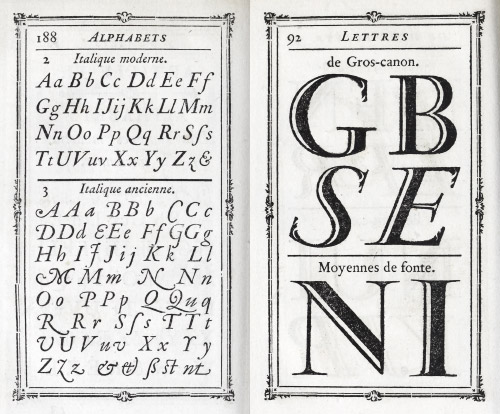 Figure 185 a & b
Fournier le jeune’s Italique moderne, Italique ancienne, and Shaded Letters
1764
Figure 185 a & b
Fournier le jeune’s Italique moderne, Italique ancienne, and Shaded Letters
1764
-
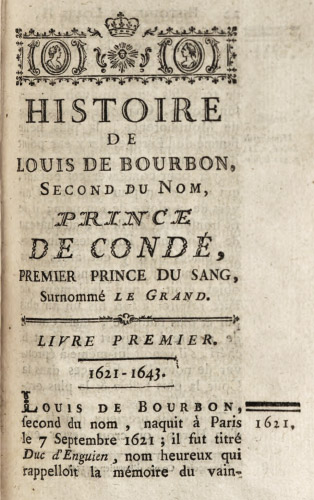 Figure 186
Fournier le jeune’s Ornamental Capitals used in Desormeaux’s Histoire de Louis II, Prince de Condé: Lottin, Paris
1768
Figure 186
Fournier le jeune’s Ornamental Capitals used in Desormeaux’s Histoire de Louis II, Prince de Condé: Lottin, Paris
1768
-
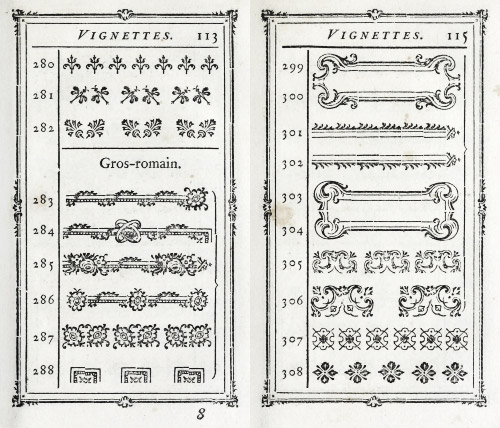 Figure 187
Fournier le jeune’s Vignettes de Fonte, Paris
1764
Figure 187
Fournier le jeune’s Vignettes de Fonte, Paris
1764
-
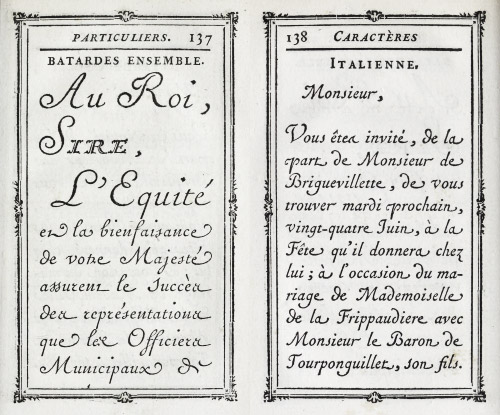 Figure 188
Batarde Types shown by Fournier, Paris
1764
Figure 188
Batarde Types shown by Fournier, Paris
1764
-
 Figure 189
Financière: Delacologne’s Caractères et Vignettes, Lyons
1773
Figure 189
Financière: Delacologne’s Caractères et Vignettes, Lyons
1773
-
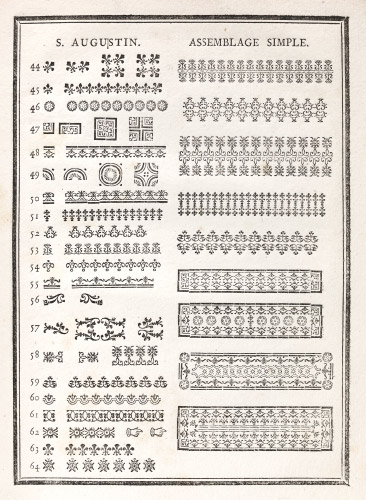 Figure 190
Method of Displaying Ornaments: Briquet’s Épreuve de Caractères, Paris
1757
Figure 190
Method of Displaying Ornaments: Briquet’s Épreuve de Caractères, Paris
1757
-
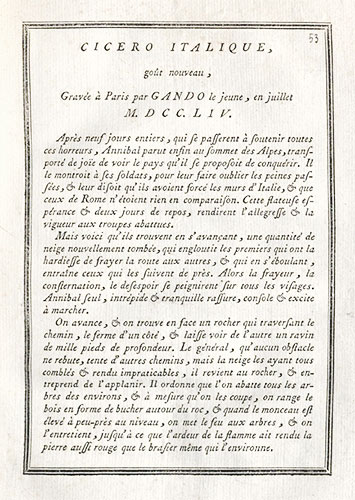 Figure 191
François Gando’s Italique, goût nouveau, cut in 1754: Épreuves de Caractères, Gando, Paris
1760
Figure 191
François Gando’s Italique, goût nouveau, cut in 1754: Épreuves de Caractères, Gando, Paris
1760
-
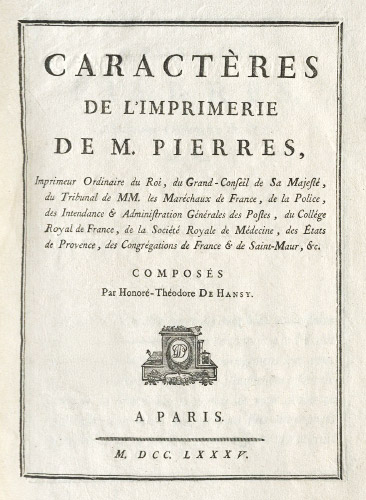 Figure 192
Title-page of Caractères de l’Imprimerie de M. Pierres, Paris
1785
Figure 192
Title-page of Caractères de l’Imprimerie de M. Pierres, Paris
1785
-
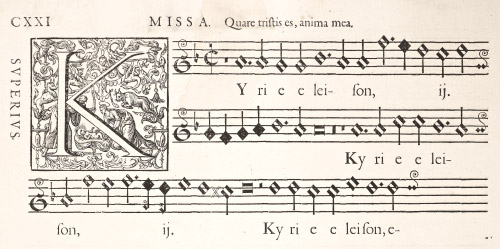 Figure 193
Music Types employed in De La Hèe’s Masses: Plantin, Antwerp
1578
Figure 193
Music Types employed in De La Hèe’s Masses: Plantin, Antwerp
1578
-
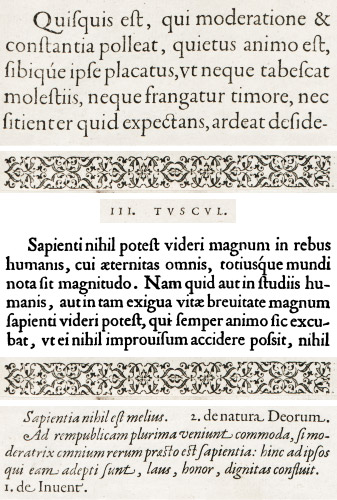 Figure 194
Roman and Italic Types: Plantin Specimen, Antwerp
1567
Figure 194
Roman and Italic Types: Plantin Specimen, Antwerp
1567
-
 Figure 195
Roman and Italic Types: Plantin Specimen, Antwerp
1567
Figure 195
Roman and Italic Types: Plantin Specimen, Antwerp
1567
-
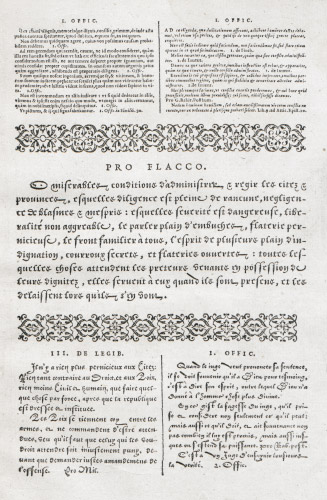 Figure 196
Roman, Italic, and Cursive Types: Plantin Specimen, Antwerp
1567
Figure 196
Roman, Italic, and Cursive Types: Plantin Specimen, Antwerp
1567
-
 Figure 197
Canon d’Espagne from Plantin Office
1905
Figure 197
Canon d’Espagne from Plantin Office
1905
-
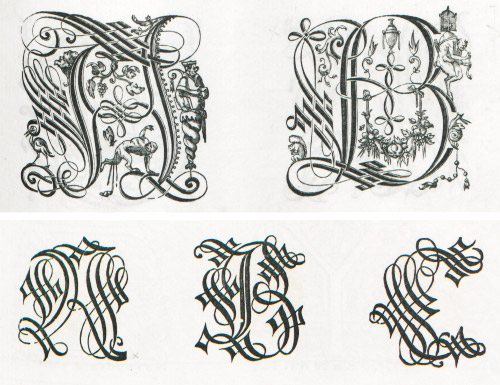 Figure 198
Calligraphic Initials from Plantin Office
1905
Figure 198
Calligraphic Initials from Plantin Office
1905
-
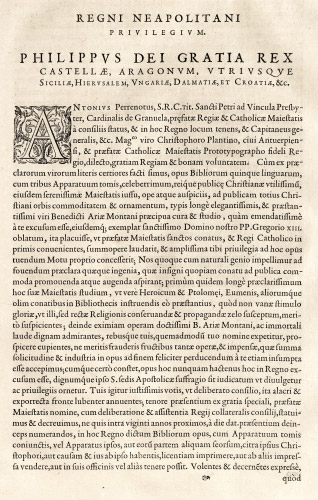 Figure 199
Page from Biblia Polyglotta: Plantin, Antwerp
1572
Figure 199
Page from Biblia Polyglotta: Plantin, Antwerp
1572
-
 Figure 200
Text-page and Title in Plantin&rsuo;s early manner, Antwerp
1567
Figure 200
Text-page and Title in Plantin&rsuo;s early manner, Antwerp
1567
-
 Figure 201
Page from Rariorum Stirpium Hispaniæ Historia: Plantin, Antwerp
1576
Figure 201
Page from Rariorum Stirpium Hispaniæ Historia: Plantin, Antwerp
1576
-
 Figure 202
Page of Rechten, end Costumen van Antwerpen, Plantin
1582
Figure 202
Page of Rechten, end Costumen van Antwerpen, Plantin
1582
-
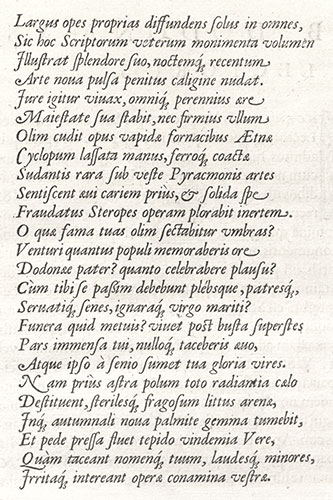 Figure 203
Page of Italic from Rembert Dodoen’s Stirpium Historia: Plantin Office, Antwerp
1616
Figure 203
Page of Italic from Rembert Dodoen’s Stirpium Historia: Plantin Office, Antwerp
1616
-
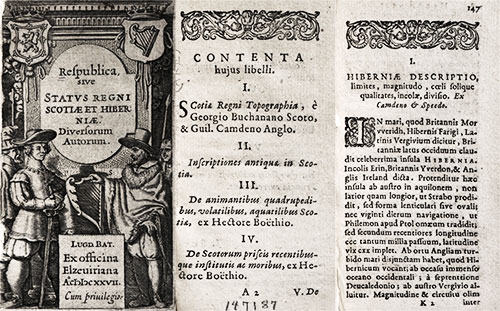 Figure 204
Title-page, Contents, and Text-page of one of Elzevir’s Republics, Leyden
1627
Figure 204
Title-page, Contents, and Text-page of one of Elzevir’s Republics, Leyden
1627
-
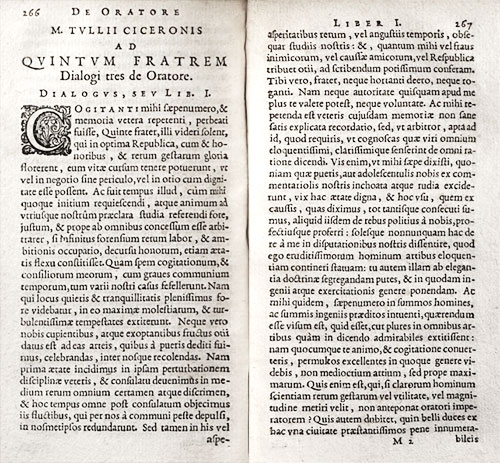 Figure 205
Pages of Cicero: Elzevir, Leyden
1642
Figure 205
Pages of Cicero: Elzevir, Leyden
1642
-
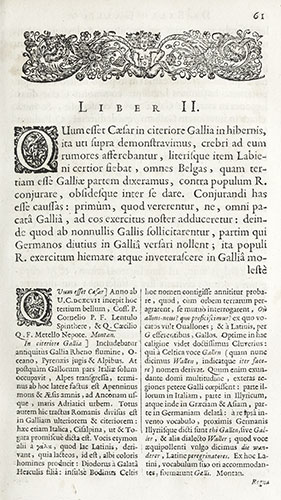 Figure 206
Page of Caesar (octavo): Elzevir, Amsterdam
1661
Figure 206
Page of Caesar (octavo): Elzevir, Amsterdam
1661
-
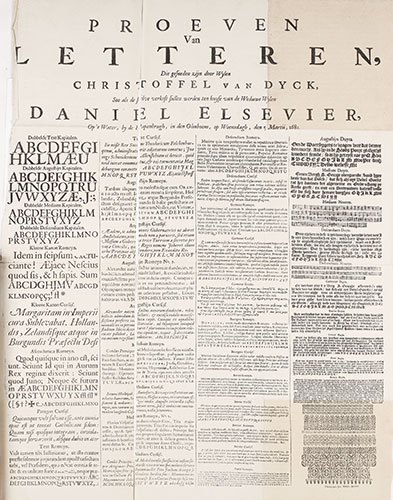 Figure 207
Sale-Specimen of Elzevir Types: Amsterdam
1681
Figure 207
Sale-Specimen of Elzevir Types: Amsterdam
1681
-
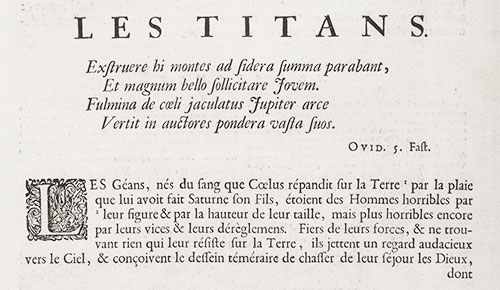 Figure 208
Dutch Type used in Temple des Muses, Amsterdam
1733
Figure 208
Dutch Type used in Temple des Muses, Amsterdam
1733
-
 Figure 209
Type used in De Stad Haarlem en haare Geschiedenissen: Enschedé and Bosch, Haarlem
1765
Figure 209
Type used in De Stad Haarlem en haare Geschiedenissen: Enschedé and Bosch, Haarlem
1765
-
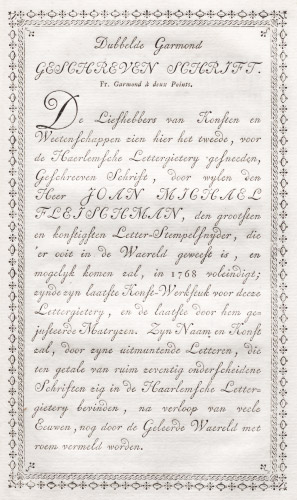 Figure 210
Script Type: Enschedé’s Proef van Letteren, Haarlem
1768
Figure 210
Script Type: Enschedé’s Proef van Letteren, Haarlem
1768
-
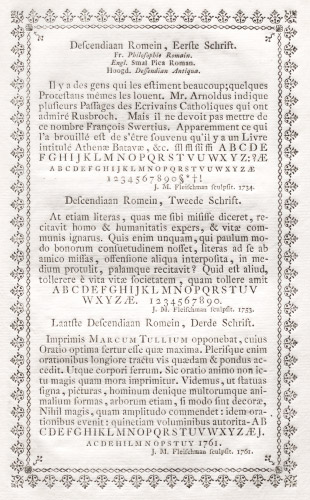 Figure 211
Fleischman’s Roman Types cut in 1734, 1753, and 1761: Enschedé’s Proef van Letteren, Haarlem
1768
Figure 211
Fleischman’s Roman Types cut in 1734, 1753, and 1761: Enschedé’s Proef van Letteren, Haarlem
1768
-
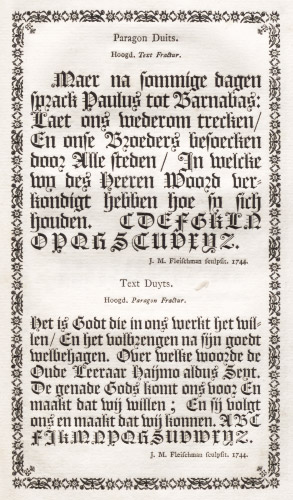 Figure 212
Fleischman’s Black-letter: Enschedé’s Proef van Letteren, Haarlem
1768
Figure 212
Fleischman’s Black-letter: Enschedé’s Proef van Letteren, Haarlem
1768
-
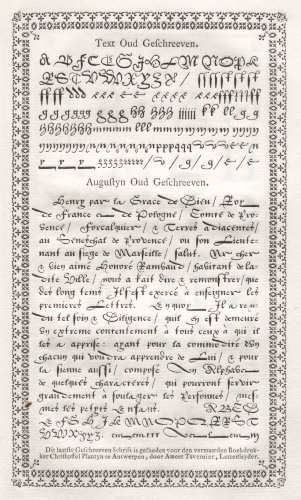 Figure 213
Seventeenth Century Civilité: Enschedé’s Proef van Letteren, Haarlem
1768
Figure 213
Seventeenth Century Civilité: Enschedé’s Proef van Letteren, Haarlem
1768
-
 Figure 214
Rosart’s Caractère de Finance, from his Épreuve, Brussels
1768
Figure 214
Rosart’s Caractère de Finance, from his Épreuve, Brussels
1768
-
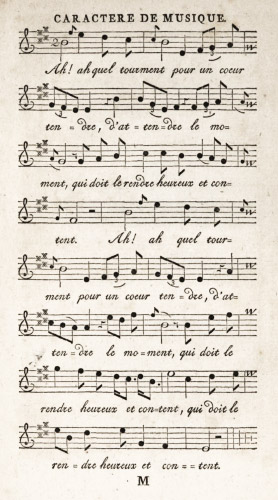 Figure 215
Rosart’s Music Types, from his Épreuve, Brussels
1768
Figure 215
Rosart’s Music Types, from his Épreuve, Brussels
1768
-
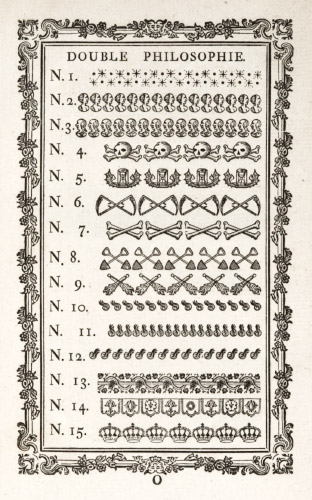 Figure 216
Rosart’s Ornaments, from his Épreuve, Brussels
1768
Figure 216
Rosart’s Ornaments, from his Épreuve, Brussels
1768
-
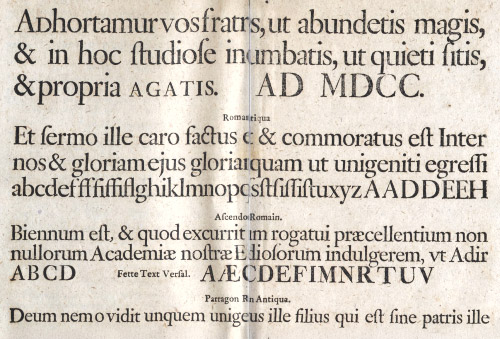 Figure 217
Dutch Roman Types: Erhardt Foundry Specimen, Leipsick
1739
Figure 217
Dutch Roman Types: Erhardt Foundry Specimen, Leipsick
1739
-
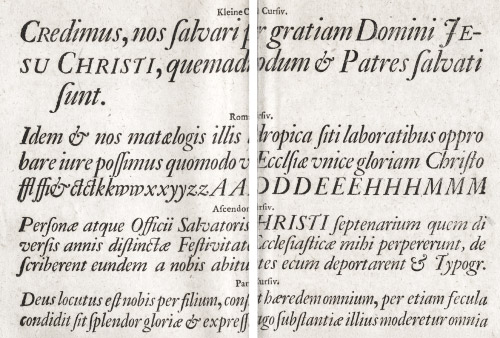 Figure 218
Dutch Italic Types: Erhardt Foundry Specimen, Leipsick
1739
Figure 218
Dutch Italic Types: Erhardt Foundry Specimen, Leipsick
1739
-
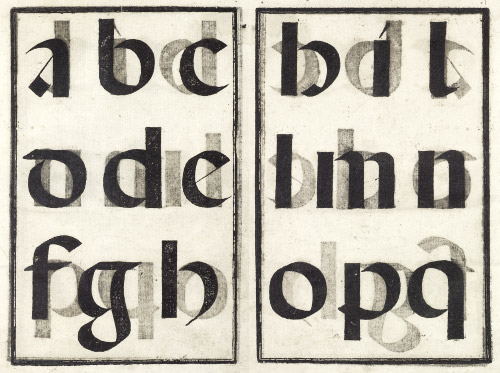 Figure 219
Round Spanish Black-letter, from Lucas’ Arte de Escrivir, Madrid
1577
Figure 219
Round Spanish Black-letter, from Lucas’ Arte de Escrivir, Madrid
1577
-
 Figure 220
Antique Black-letter: Specimen of La Fabrica del Convento de S. Joseph, Barcelona
1777
Figure 220
Antique Black-letter: Specimen of La Fabrica del Convento de S. Joseph, Barcelona
1777
-
 Figure 221
Title-page of Bordazar’s Plantificacion, Valencia
1732
Figure 221
Title-page of Bordazar’s Plantificacion, Valencia
1732
-
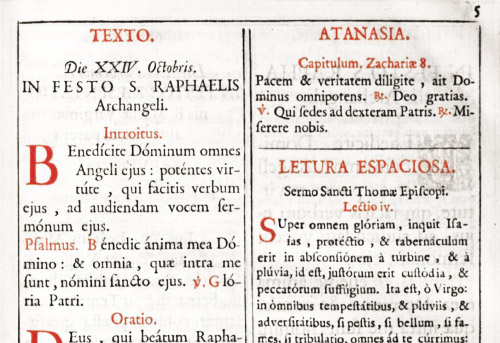 Figure 222
Texto, Atanasia, and Lettura Espaciosa from Boradzar’s Plantificacion, Valencia
1732
Figure 222
Texto, Atanasia, and Lettura Espaciosa from Boradzar’s Plantificacion, Valencia
1732
-
 Figure 223
Page of Sallust: Ibarra, Madrid
1772
Figure 223
Page of Sallust: Ibarra, Madrid
1772
-
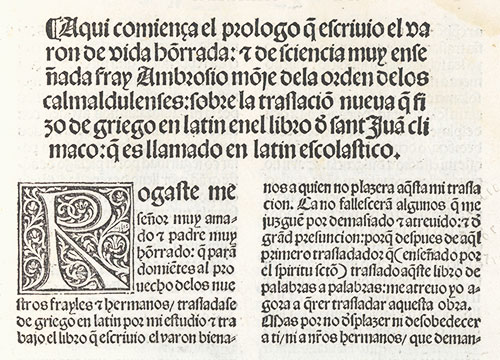 Figure 224
Gothic Types: Hagenbach, Toledo
1504
Figure 224
Gothic Types: Hagenbach, Toledo
1504
-
 Figure 225
Gothic Type: Coci, Saragossa
1520
Figure 225
Gothic Type: Coci, Saragossa
1520
-
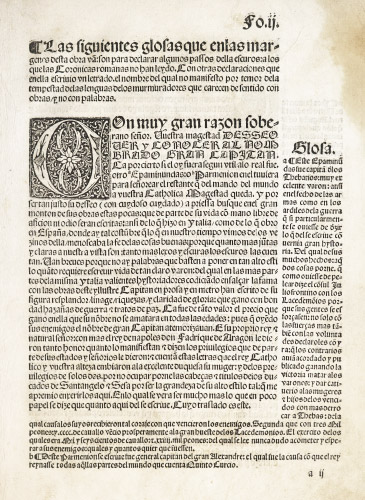 Figure 226
Gothic Type used by Cromburger, Seville
1527
Figure 226
Gothic Type used by Cromburger, Seville
1527
-
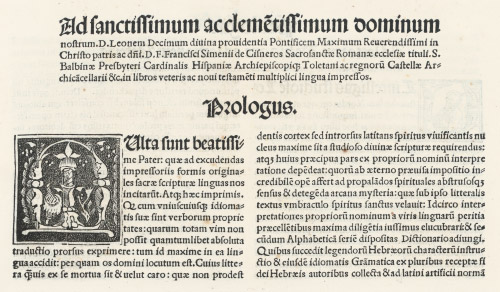 Figure 227
Roman and Gothic Types used in Complutensian Polyglot Bible: Guillen de Brocar, Alcalá
1514–17
Figure 227
Roman and Gothic Types used in Complutensian Polyglot Bible: Guillen de Brocar, Alcalá
1514–17
-
 Figure 228
Greek Type used in Complutensian Polyglot Bible (New Testament): Guillen de Brocar, Alcalá
1514–17
Figure 228
Greek Type used in Complutensian Polyglot Bible (New Testament): Guillen de Brocar, Alcalá
1514–17
-
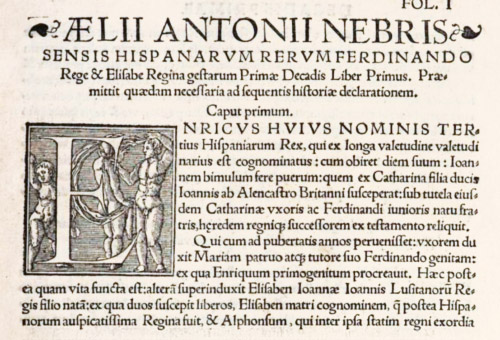 Figure 229
Roman Type used by Sancho de Nebrija, Granada
1545
Figure 229
Roman Type used by Sancho de Nebrija, Granada
1545
-
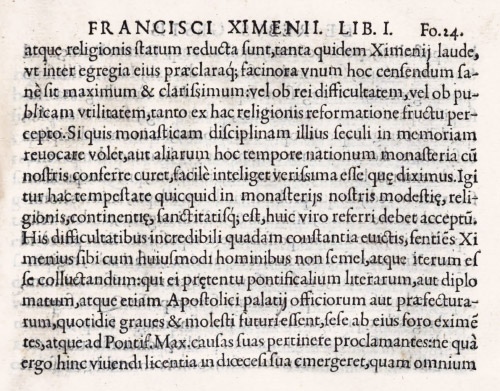 Figure 230
Roman Type used by Andres de Angulo, Alcalá
1569
Figure 230
Roman Type used by Andres de Angulo, Alcalá
1569
-
 Figure 231
Types used in first edition of Don Quixote: Juan de la Cuesta, Madrid
1605, 1615
Figure 231
Types used in first edition of Don Quixote: Juan de la Cuesta, Madrid
1605, 1615
-
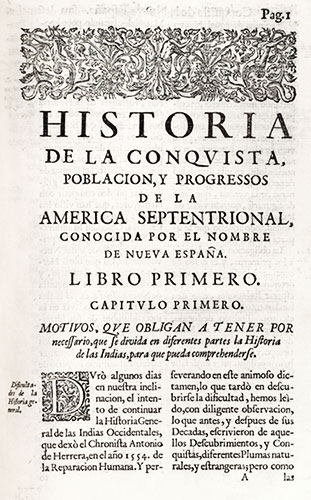 Figure 232
Opening of Solis’ Conquista de Mexico (first edition): Villa-Diego, Madrid
1684
Figure 232
Opening of Solis’ Conquista de Mexico (first edition): Villa-Diego, Madrid
1684
-
 Figure 233
Italic used for Spanish text of Sallust: Ibarra, Madrid
1772
Figure 233
Italic used for Spanish text of Sallust: Ibarra, Madrid
1772
-
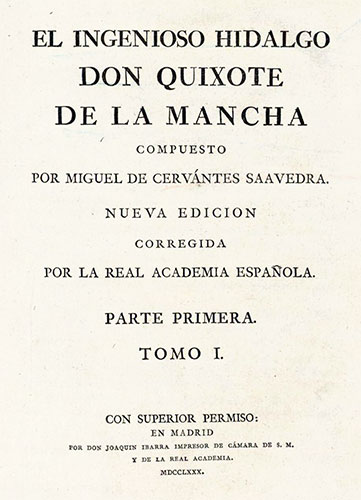 Figure 234
Title-page of Academy Edition of Don Quixote
1780
Figure 234
Title-page of Academy Edition of Don Quixote
1780
-
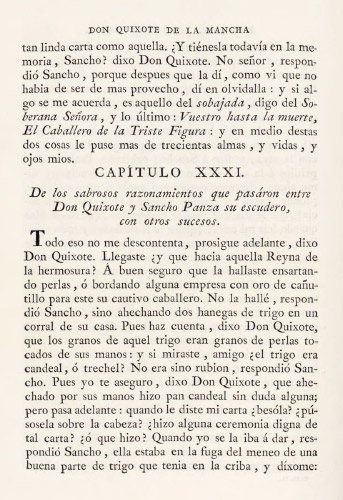 Figure 235
Types used in Academy Edition of Don Quixote: Ibarra, Madrid, 1780
1780
Figure 235
Types used in Academy Edition of Don Quixote: Ibarra, Madrid, 1780
1780
-
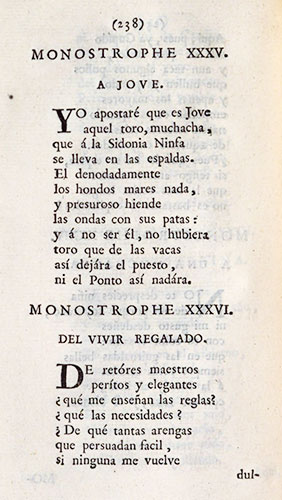 Figure 236
Type used by A. de Sancha, Madrid
1774
Figure 236
Type used by A. de Sancha, Madrid
1774
-
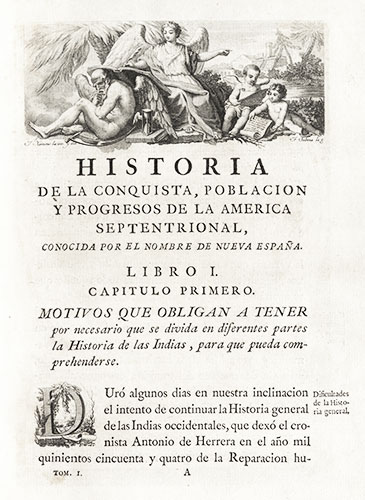 Figure 237
Opening of Solis’s Conquista de Mexico: Sancha, Madrid, 1783
1783
Figure 237
Opening of Solis’s Conquista de Mexico: Sancha, Madrid, 1783
1783
-
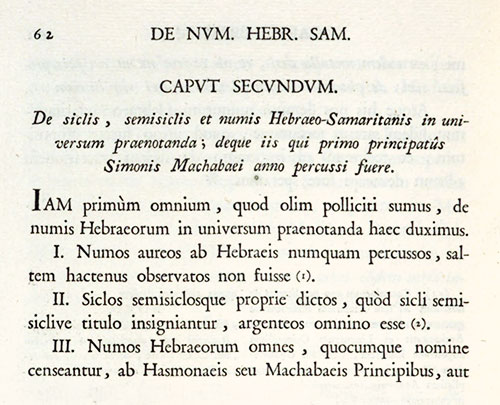 Figure 238
Type used in Bayer’s De Numis Hebræo-Samaritanis: Monfort, Valencia
1781
Figure 238
Type used in Bayer’s De Numis Hebræo-Samaritanis: Monfort, Valencia
1781
-
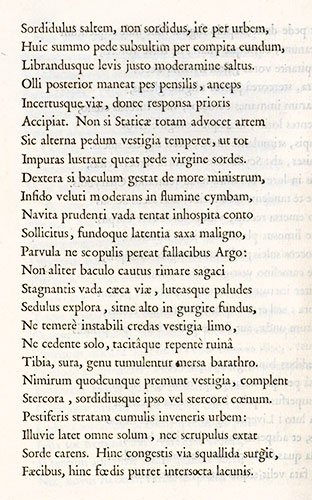 Figure 239
Page from Yriarte’s Obras Sueltas: Mena, Madrid
1774
Figure 239
Page from Yriarte’s Obras Sueltas: Mena, Madrid
1774
-
 Figure 240
Italic in Prefatory Address: Espinosa’s Murestras de los Caracters, etc., Madrid
1771
Figure 240
Italic in Prefatory Address: Espinosa’s Murestras de los Caracters, etc., Madrid
1771
-
 Figure 241
Texto Gordo (roman): Espinosa’s Murestras de los Caracters, etc., Madrid
1771
Figure 241
Texto Gordo (roman): Espinosa’s Murestras de los Caracters, etc., Madrid
1771
-
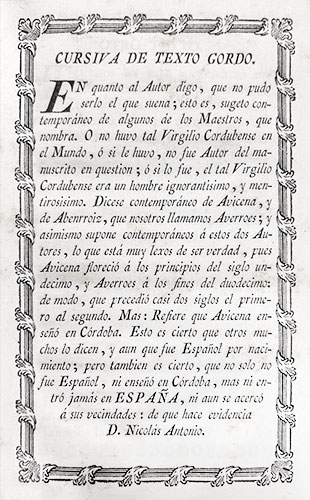 Figure 242
Texto Gordo (italic): Espinosa’s Murestras de los Caracters, etc., Madrid
1771
Figure 242
Texto Gordo (italic): Espinosa’s Murestras de los Caracters, etc., Madrid
1771
-
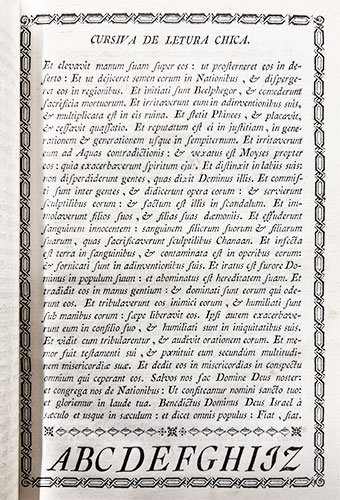 Figure 243
Italic of Letura Chica: Espinosa’s Murestras de los Caracters, etc., Madrid
1771
Figure 243
Italic of Letura Chica: Espinosa’s Murestras de los Caracters, etc., Madrid
1771
-
 Figure 244
Entredos (roman and italic): Espinosa’s Murestras de los Caracters, etc., Madrid
1771
Figure 244
Entredos (roman and italic): Espinosa’s Murestras de los Caracters, etc., Madrid
1771
-
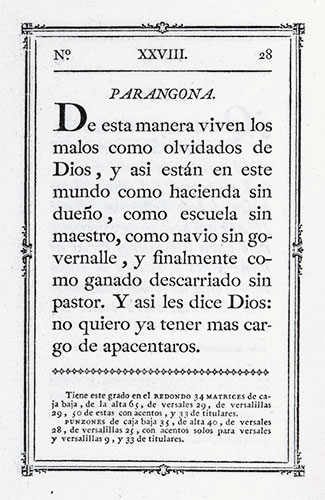 Figure 245
Roman cut by Gil: Specimen Real Biblioteca, Madrid
1787
Figure 245
Roman cut by Gil: Specimen Real Biblioteca, Madrid
1787
-
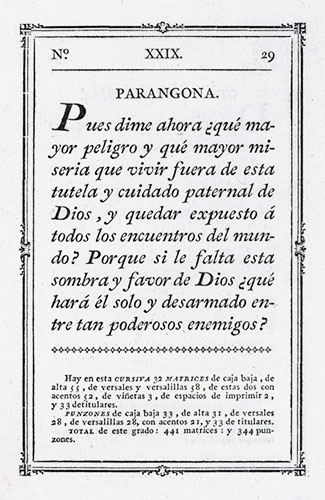 Figure 246
Italic cut by Gil: Specimen Real Biblioteca, Madrid
1787
Figure 246
Italic cut by Gil: Specimen Real Biblioteca, Madrid
1787
-
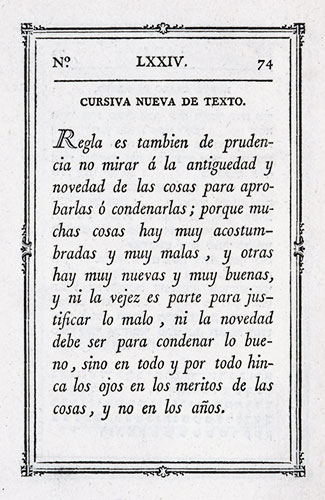 Figure 247
New Italic of Texto (showing French influence): Specimen Real Biblioteca, Madrid
1787
Figure 247
New Italic of Texto (showing French influence): Specimen Real Biblioteca, Madrid
1787
-
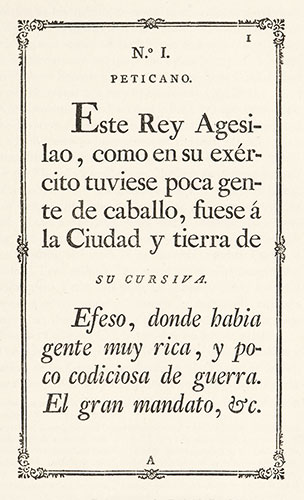 Figure 248
Peticano, cut by Eudaldo Pradell, Muestras de la Viuda é Hijo de Pradell, Madrid
1793
Figure 248
Peticano, cut by Eudaldo Pradell, Muestras de la Viuda é Hijo de Pradell, Madrid
1793
-
 Figure 249
Ornaments from Muestras, etc., Pedro, Ifern, Madrid
1795
Figure 249
Ornaments from Muestras, etc., Pedro, Ifern, Madrid
1795
-
 Figure 250
Roman tending to “Modern Face,” from Muestras, etc., Imprenta Real, Madrid
1799
Figure 250
Roman tending to “Modern Face,” from Muestras, etc., Imprenta Real, Madrid
1799
-
 Figure 251
Italic tending to “Modern Face,” from Muestras, etc., Imprenta Real, Madrid
1799
Figure 251
Italic tending to “Modern Face,” from Muestras, etc., Imprenta Real, Madrid
1799
-
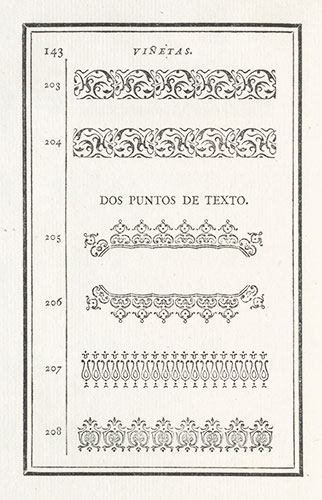 Figure 252
Ornaments from Muestras, etc., Imprenta Real, Madrid
1799
Figure 252
Ornaments from Muestras, etc., Imprenta Real, Madrid
1799
-
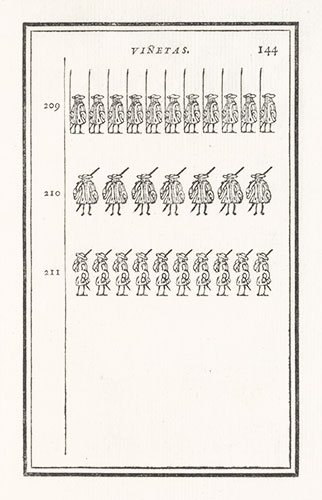 Figure 253
Ornaments from Muestras, etc., Imprenta Real, Madrid
1799
Figure 253
Ornaments from Muestras, etc., Imprenta Real, Madrid
1799
-
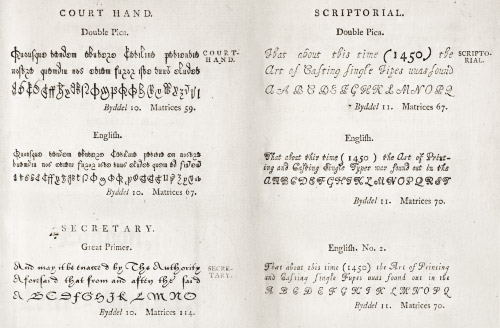 Figure 254
Court Hand, Secretary, and Scriptorial Types from Sale Catalogue of the James Foundry, London
1782
Figure 254
Court Hand, Secretary, and Scriptorial Types from Sale Catalogue of the James Foundry, London
1782
-
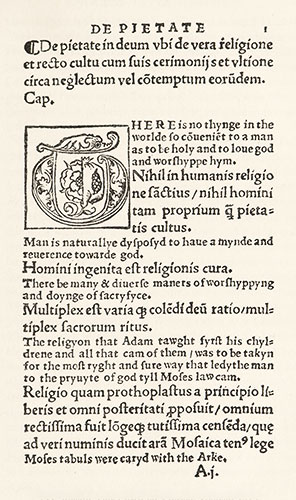 Figure 255
Roman Types used in Horman’s Vulgaria: Pynson, London
1519
Figure 255
Roman Types used in Horman’s Vulgaria: Pynson, London
1519
-
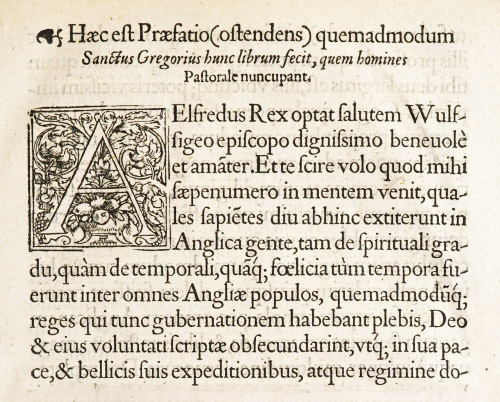 Figure 256
Roman Type used in Æfredi Regis Res Gestæ: Day, London
1574
Figure 256
Roman Type used in Æfredi Regis Res Gestæ: Day, London
1574
-
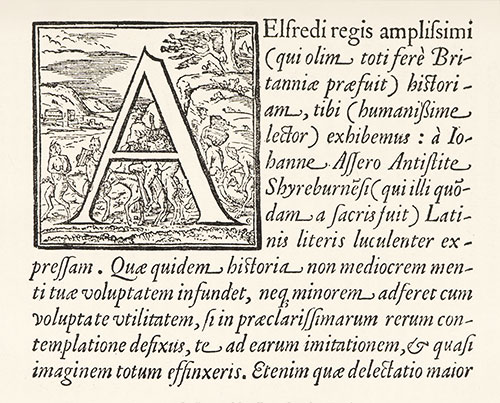 Figure 257
Italic used in Horman’s Vulgaria: Pynson, London
1650
Figure 257
Italic used in Horman’s Vulgaria: Pynson, London
1650
-
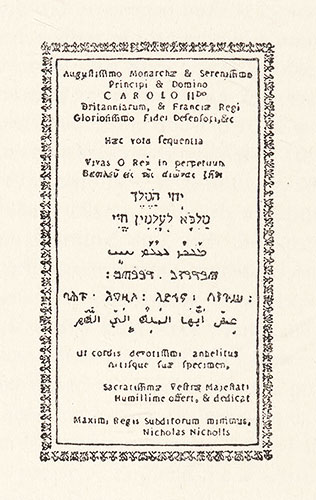 Figure 258
Earliest English Specimen-sheet: Nicholas Nicholls, London
1665
Figure 258
Earliest English Specimen-sheet: Nicholas Nicholls, London
1665
-
 Figure 259
Roman and Italic given by Dr. Fell to the University Press, Oxford
1695
Figure 259
Roman and Italic given by Dr. Fell to the University Press, Oxford
1695
-
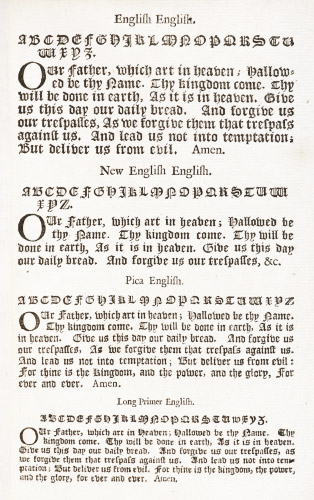 Figure 260
Black-letter given by Dr. Fell to the University Press, Oxford
1695
Figure 260
Black-letter given by Dr. Fell to the University Press, Oxford
1695
-
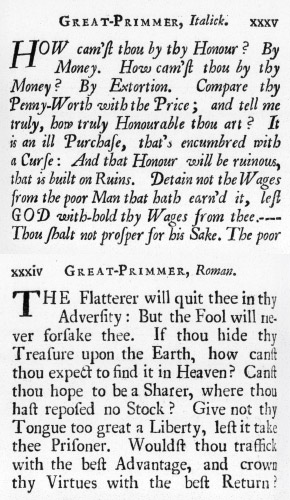 Figure 261
Dutch types used in England: Watson Specimen, Edinburgh
1713
Figure 261
Dutch types used in England: Watson Specimen, Edinburgh
1713
-
 Figure 262
First Broadside Specimen issued by William Caslon
1734
Figure 262
First Broadside Specimen issued by William Caslon
1734
-
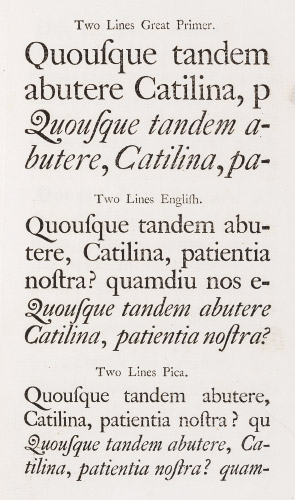 Figure 263
Roman and Italic: William Caslon & Son’s Specimen, London
1763
Figure 263
Roman and Italic: William Caslon & Son’s Specimen, London
1763
-
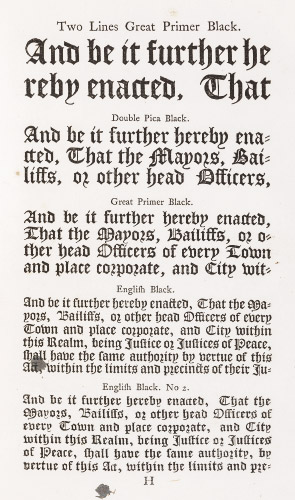 Figure 264
Black-letter: William Caslon & Son’s Specimen, London
1763
Figure 264
Black-letter: William Caslon & Son’s Specimen, London
1763
-
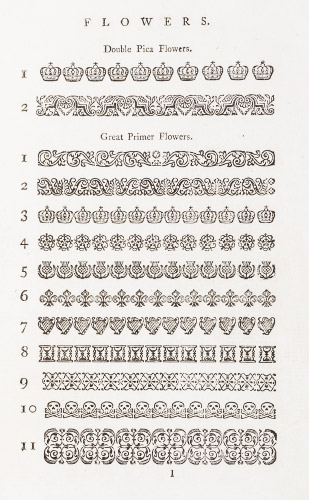 Figures 265 & 266
Ornaments: William Caslon & Son’s Specimen, London
1763
Figures 265 & 266
Ornaments: William Caslon & Son’s Specimen, London
1763
-
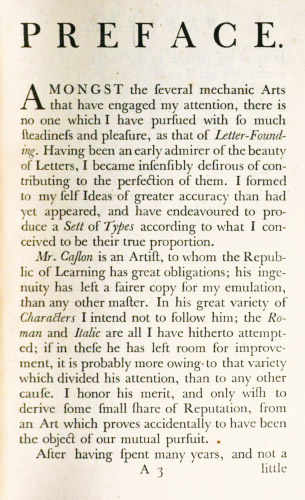 Figure 267
Page of Bakerville’s Preface to Milton, Birmingham
1758
Figure 267
Page of Bakerville’s Preface to Milton, Birmingham
1758
-
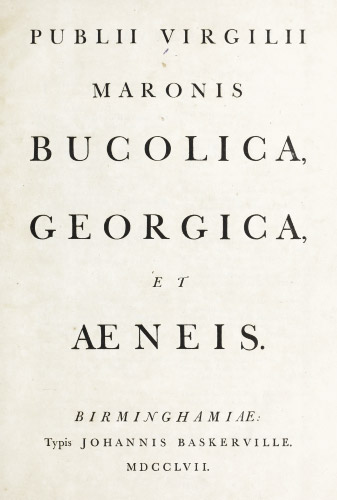 Figure 268
Title-page of Baskerville’s Virgil, Birmingham
1757
Figure 268
Title-page of Baskerville’s Virgil, Birmingham
1757
-
 Figure 269
Baskerville’s Type used in Virgil, Birmingham
1757
Figure 269
Baskerville’s Type used in Virgil, Birmingham
1757
-
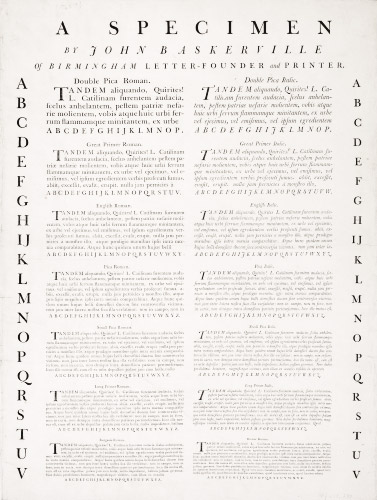 Figure 270
Baskerville’s Broadside Specimen (without border), Birmingham
1762
Figure 270
Baskerville’s Broadside Specimen (without border), Birmingham
1762
-
 Figure 271
Types from Baskerville’s bordered Broadside Specimen, Birmingham
1762
Figure 271
Types from Baskerville’s bordered Broadside Specimen, Birmingham
1762
-
 Figure 272
Advertisement of Sales of Baskerville’s Types, Paris
1789
Figure 272
Advertisement of Sales of Baskerville’s Types, Paris
1789
-
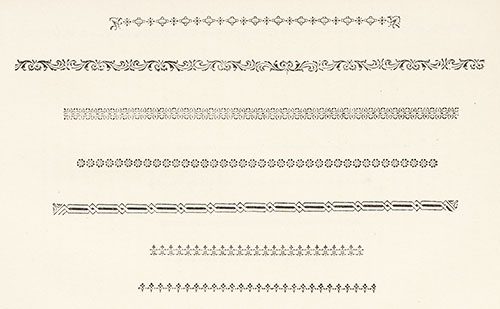 Figures 273 & 274
Ornaments used by Baskerville
1775
Figures 273 & 274
Ornaments used by Baskerville
1775
-
 Figure 275
Portion of Wilson’s Broadside Specimen, Glasgow
1783
Figure 275
Portion of Wilson’s Broadside Specimen, Glasgow
1783
-
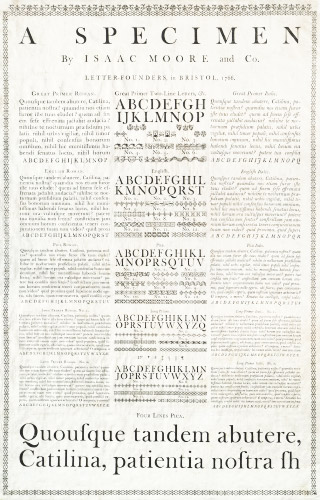 Figure 276
Broadside Specimen of Isaac Moore and Co., Bristol
1766
Figure 276
Broadside Specimen of Isaac Moore and Co., Bristol
1766
-
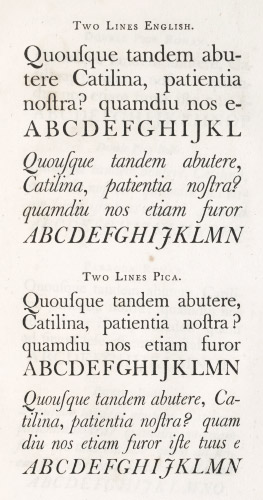 Figure 277
Roman and Italic: Fry and Steel’s Specimen, London
1795
Figure 277
Roman and Italic: Fry and Steel’s Specimen, London
1795
-
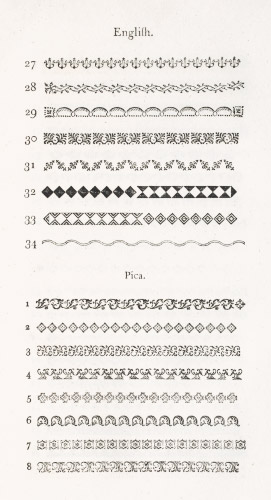 Figure 278
Ornaments: Fry and Steel’s Specimen, London
1795
Figure 278
Ornaments: Fry and Steel’s Specimen, London
1795
-
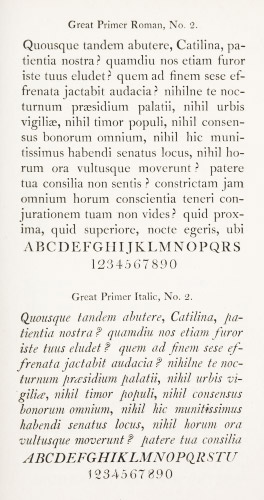 Figure 279
Transitional Types: Caslon Specimen, London
1798
Figure 279
Transitional Types: Caslon Specimen, London
1798
-
 Figure 280
Ornaments: Caslon Specimen, London
1798
Figure 280
Ornaments: Caslon Specimen, London
1798
-
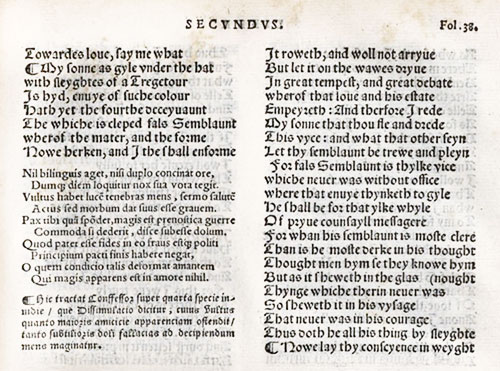 Figure 281
Types used on Gower’s Confessio Amantis: Berthelet, London, 1532
1532
Figure 281
Types used on Gower’s Confessio Amantis: Berthelet, London, 1532
1532
-
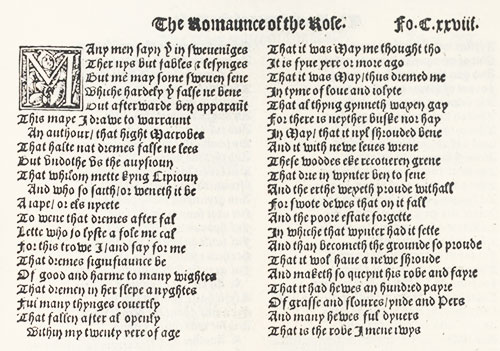 Figure 282
Lettre Batarde used in first complete edition of Chaucer: Godfrey, London
1532
Figure 282
Lettre Batarde used in first complete edition of Chaucer: Godfrey, London
1532
-
 Figure 283
Lettre de Forme used in second complete edition of Chaucer: Pynson, London
1542
Figure 283
Lettre de Forme used in second complete edition of Chaucer: Pynson, London
1542
-
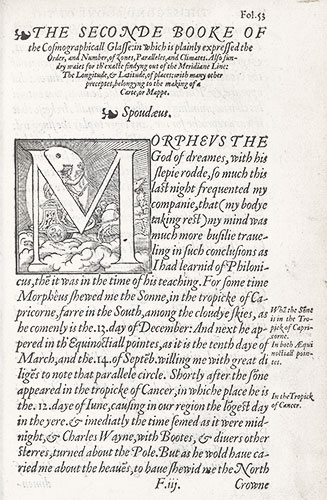 Figure 284
Page of Cunningham’s Cosmographicall Glasse: Day, London
1559
Figure 284
Page of Cunningham’s Cosmographicall Glasse: Day, London
1559
-
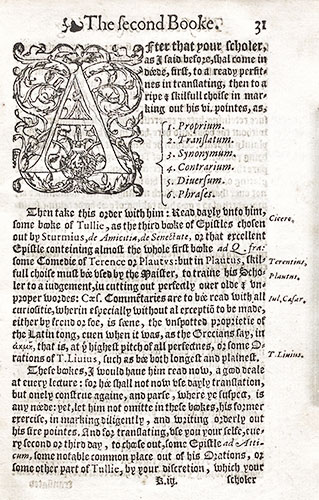 Figure 285
Page of Ascham’s Scholemaster, showing Roman, Italic, and Black-letter: Day, Londo
1751
Figure 285
Page of Ascham’s Scholemaster, showing Roman, Italic, and Black-letter: Day, Londo
1751
-
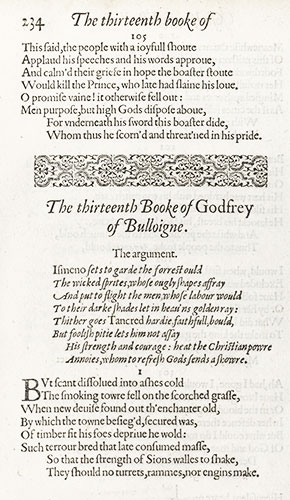 Figure 286
Type and Ornaments in Tasso’s Godfrey of Bulloigne: Hatfield, London
1600
Figure 286
Type and Ornaments in Tasso’s Godfrey of Bulloigne: Hatfield, London
1600
-
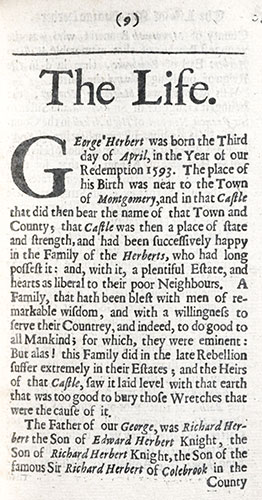 Figure 287
Page of Walton’s Lives: Newcomb, London
1670
Figure 287
Page of Walton’s Lives: Newcomb, London
1670
-
 Figure 288
Page of English-Saxon Homily: Bowyer, London
1709
Figure 288
Page of English-Saxon Homily: Bowyer, London
1709
-
 Figure 289
Roman used in Latin edition of Caesar: Tonson, London
1712
Figure 289
Roman used in Latin edition of Caesar: Tonson, London
1712
-
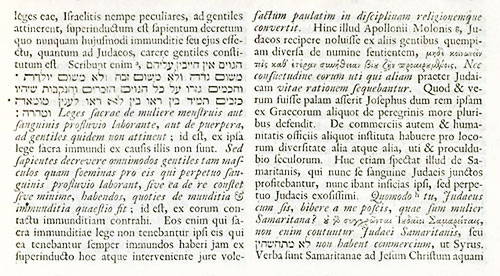 Figure 290
First use of Caslon’s Roman Type, in Selden’s Opera: Bowyer, London
1726
Figure 290
First use of Caslon’s Roman Type, in Selden’s Opera: Bowyer, London
1726
-
 Figure 291
Engraved Text of Pine’s Horace, London
1733–1737
Figure 291
Engraved Text of Pine’s Horace, London
1733–1737
-
 Figure 292
Type of Hanmer’s Shakespeare: University Press, Oxford
1743–1744
Figure 292
Type of Hanmer’s Shakespeare: University Press, Oxford
1743–1744
-
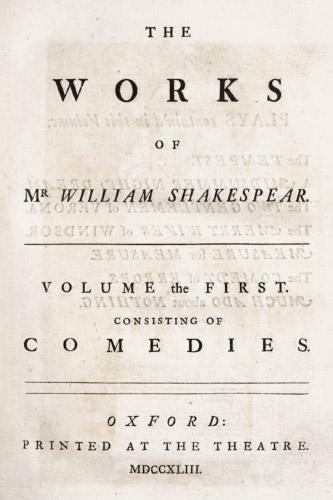 Figure 293
Bastard Title-page of Hanmer’s Shakespeare: University Press, Oxford
1743–1744
Figure 293
Bastard Title-page of Hanmer’s Shakespeare: University Press, Oxford
1743–1744
-
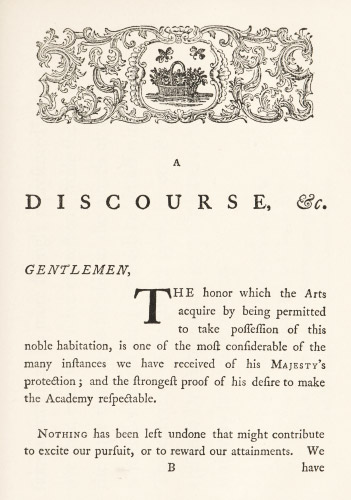 Figure 294
Page of Sir Joshua Reynolds’ Royal Academy Discourse: Cadell, London
1782
Figure 294
Page of Sir Joshua Reynolds’ Royal Academy Discourse: Cadell, London
1782
-
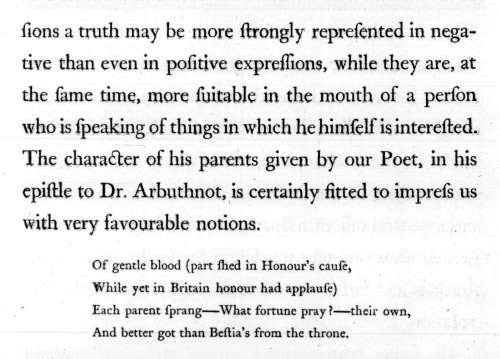 Figure 295
Type of folio Pope: Foulis, Glasgow
1785
Figure 295
Type of folio Pope: Foulis, Glasgow
1785
-
 Figure 296
Title-page of Letters of Charlotte, London
1786
Figure 296
Title-page of Letters of Charlotte, London
1786
-
 Figure 297
William Martin’s Type used in the “Boydell Shakspeare”: Bulmer, London
1792–1801
Figure 297
William Martin’s Type used in the “Boydell Shakspeare”: Bulmer, London
1792–1801
-
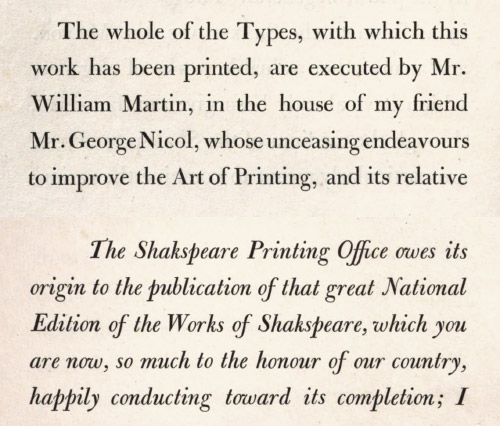 Figure 298
William Martin’s Two-line Small Pica Roman and Italic used in Poems by Goldsmith and Parnell: Bulmer, London
1795
Figure 298
William Martin’s Two-line Small Pica Roman and Italic used in Poems by Goldsmith and Parnell: Bulmer, London
1795
-
 Figure 299
William Martin’s Great Primer Roman (Goldsmith and Parnell) and Italic (Somervile’s Chase): Bulmer, London
1795–1796
Figure 299
William Martin’s Great Primer Roman (Goldsmith and Parnell) and Italic (Somervile’s Chase): Bulmer, London
1795–1796
-
 Figure 300
William Martin’s Pica Roman and Italic used in Somervile’s Chase: Bulmer, London
1796
Figure 300
William Martin’s Pica Roman and Italic used in Somervile’s Chase: Bulmer, London
1796
-
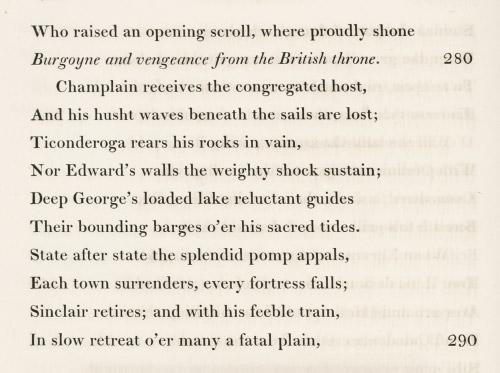 Figure 301
Binny & Ronaldson’s Type used in The Columbiad, Philadelphia
1807
Figure 301
Binny & Ronaldson’s Type used in The Columbiad, Philadelphia
1807
-
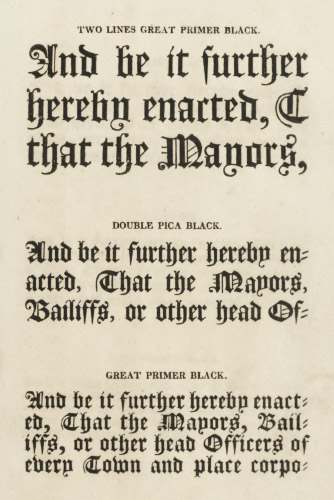 Figure 302
Black-letter: Binny & Ronaldson’s Specimen, Philadelphia
1812
Figure 302
Black-letter: Binny & Ronaldson’s Specimen, Philadelphia
1812
-
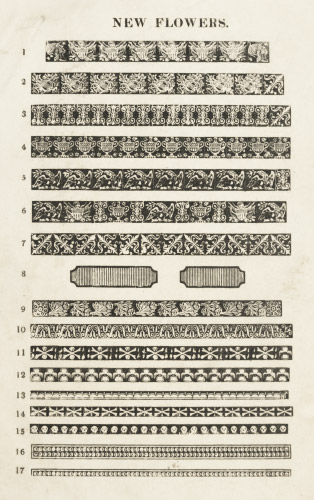 Figure 303
Ornaments: Binny & Ronaldson’s Specimen, Philadelphia
1812
Figure 303
Ornaments: Binny & Ronaldson’s Specimen, Philadelphia
1812
-
 Figure 304
Title-page: Isaiah Thomas’s Specimen, Worcester
1785
Figure 304
Title-page: Isaiah Thomas’s Specimen, Worcester
1785
-
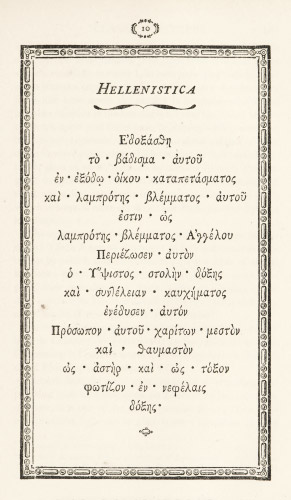 Figure 305
Greek from Iscrizioni Esotici: Bodoni, Parma
1774
Figure 305
Greek from Iscrizioni Esotici: Bodoni, Parma
1774
-
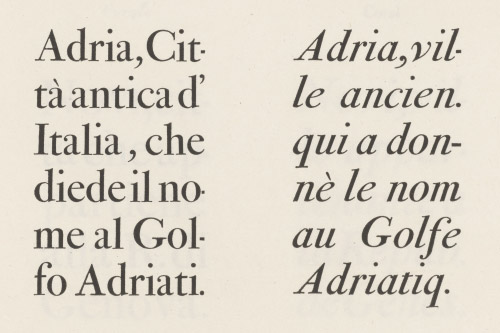 Figure 306
Roman and Italic from Bodoni’s Specimen, Parma
1788
Figure 306
Roman and Italic from Bodoni’s Specimen, Parma
1788
-
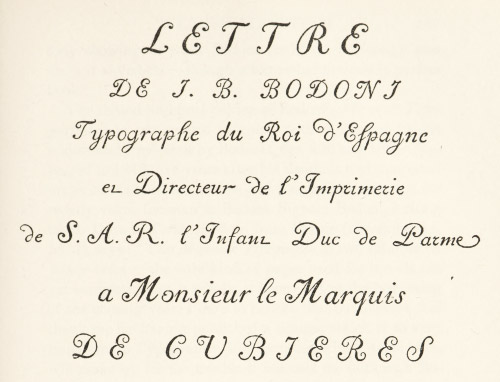 Figure 307 a & b
Title and Text of Lettre à De Cubières: Bodoni, Parma
1785
Figure 307 a & b
Title and Text of Lettre à De Cubières: Bodoni, Parma
1785
-
 Figure 308
Page of Signora Bodoni’s Discorso: Manuale Tipografico, Parma
1818
Figure 308
Page of Signora Bodoni’s Discorso: Manuale Tipografico, Parma
1818
-
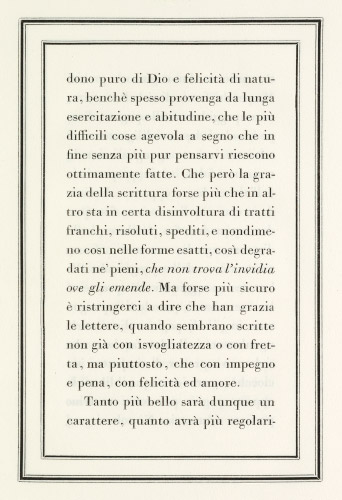 Figure 309
Page of Signora Bodoni’s Prefazione: Manuale Tipografico
1818
Figure 309
Page of Signora Bodoni’s Prefazione: Manuale Tipografico
1818
-
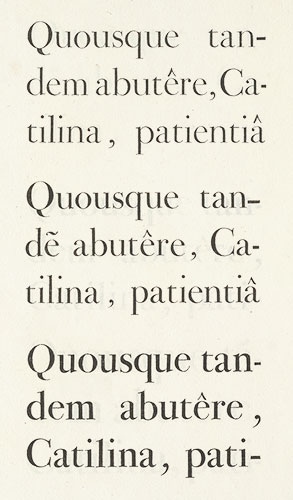 Figure 310
Specimen of Bodoni’s Ducale in three weights: Manuale Tipografico, Parma
1818
Figure 310
Specimen of Bodoni’s Ducale in three weights: Manuale Tipografico, Parma
1818
-
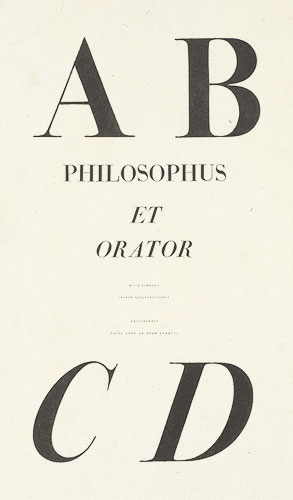 Figure 311
Largest, medium, and smallest Roman and Italic Capitals shown in Bodoni’s Manuale Tipografico, Parma
1818
Figure 311
Largest, medium, and smallest Roman and Italic Capitals shown in Bodoni’s Manuale Tipografico, Parma
1818
-
 Figure 312
Ornaments: Bodoni’s Manuale Tipografico, Parma
1818
Figure 312
Ornaments: Bodoni’s Manuale Tipografico, Parma
1818
-
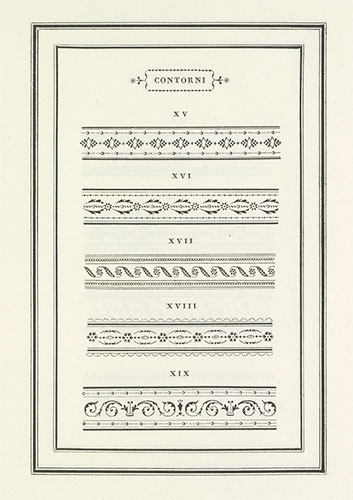 Figure 313
Borders: Bodoni’s Manuale Tipografico, Parma
1818
Figure 313
Borders: Bodoni’s Manuale Tipografico, Parma
1818
-
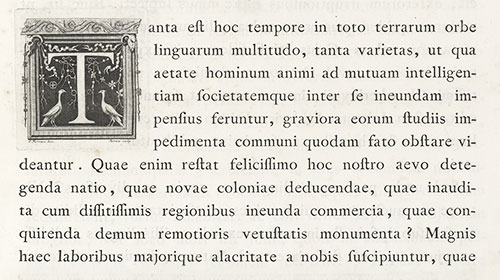 Figure 314
Roman in Epithalamia Exoticis Linguis Reddita: Bodoni, Parma
1775
Figure 314
Roman in Epithalamia Exoticis Linguis Reddita: Bodoni, Parma
1775
-
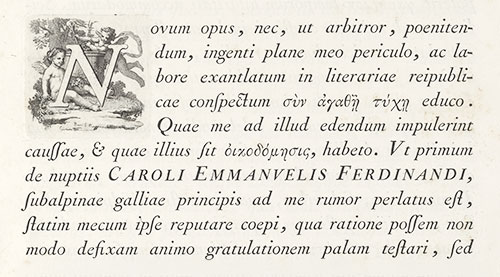 Figure 315
Italic in Epithalamia Exoticis Linguis Reddita: Bodoni, Parma
1775
Figure 315
Italic in Epithalamia Exoticis Linguis Reddita: Bodoni, Parma
1775
-
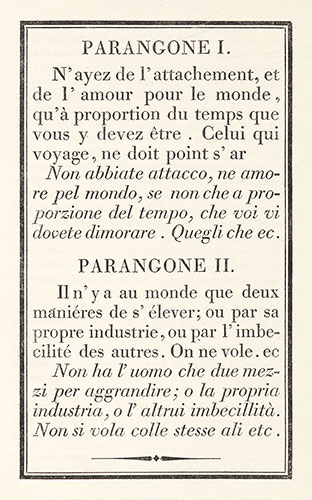 Figure 316
Roman and Italic: Amoretti’s Saggio de’ Caratteri, Parma
1811
Figure 316
Roman and Italic: Amoretti’s Saggio de’ Caratteri, Parma
1811
-
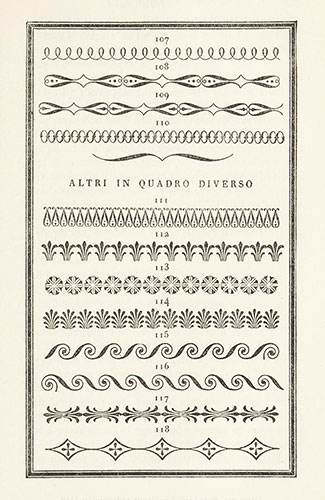 Figure 317
Ornaments: Amoretti’s Saggio de’ Caratteri, Parma
1811
Figure 317
Ornaments: Amoretti’s Saggio de’ Caratteri, Parma
1811
-
 Figure 318
talic in P. Didot l’aîné’s Spécimen des Nouveaux Caractères, Paris
1819
Figure 318
talic in P. Didot l’aîné’s Spécimen des Nouveaux Caractères, Paris
1819
-
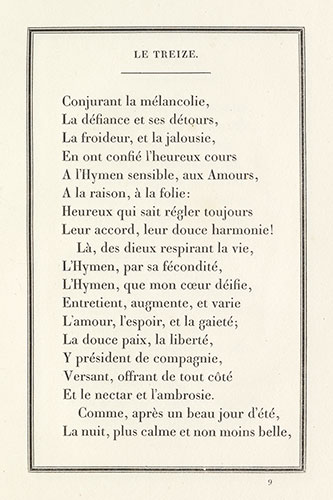 Figure 319
Roman in P. Didot’s Spécimen etc., Paris
1819
Figure 319
Roman in P. Didot’s Spécimen etc., Paris
1819
-
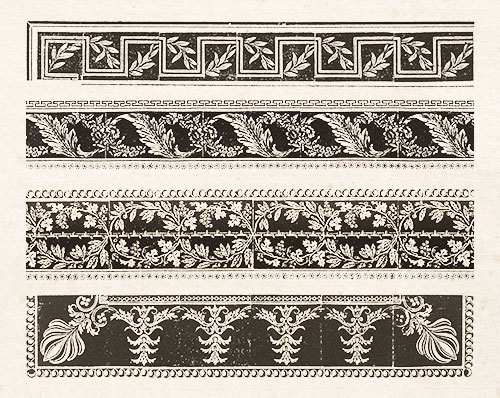 Figure 320
Borders: Specimen of Gillé fils, Paris
1808
Figure 320
Borders: Specimen of Gillé fils, Paris
1808
-
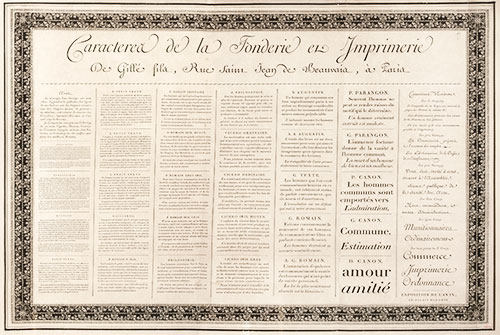 Figure 321
Broadside Specimen of Gillé fils, Paris
1808
Figure 321
Broadside Specimen of Gillé fils, Paris
1808
-
 Figure 322
Sheet from folio Specimen of Molé jeune, Paris
1819
Figure 322
Sheet from folio Specimen of Molé jeune, Paris
1819
-
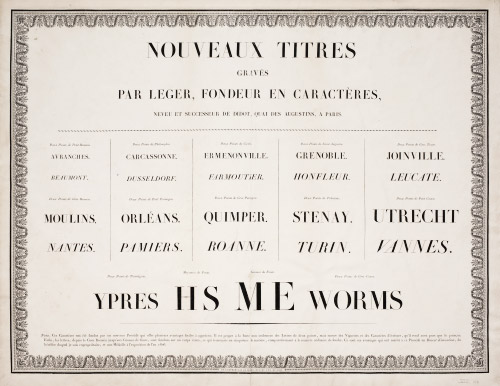 Figure 323
Broadside Specimen of L. Léger, Paris
1806
Figure 323
Broadside Specimen of L. Léger, Paris
1806
-
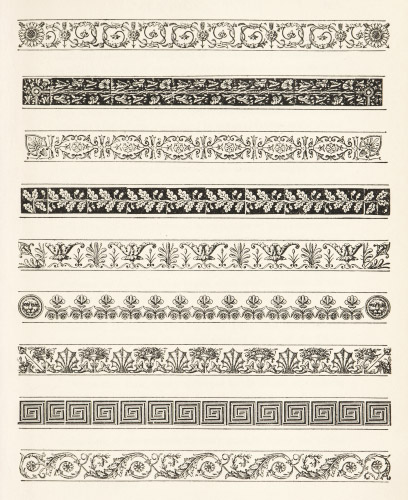 Figure 324
Borders: Léger’s Spécimen des Divers Caractères, Paris
1831–1844
Figure 324
Borders: Léger’s Spécimen des Divers Caractères, Paris
1831–1844
-
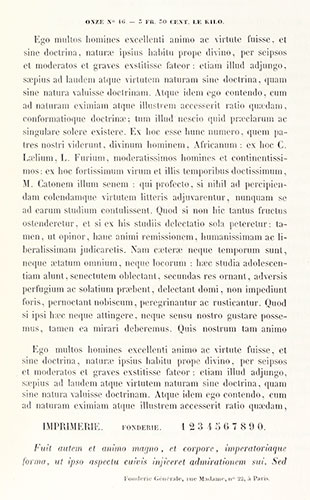 Figure 325
“Classic” Types: Épreuves de Caractères, Fonderie Générale, Paris,
Figure 325
“Classic” Types: Épreuves de Caractères, Fonderie Générale, Paris, 18431853 1853 -
 Figure 326
French Old Style revived by De Berny, Paris
1852
Figure 326
French Old Style revived by De Berny, Paris
1852
-
 Figure 327
Comparative Table of Types used by the French National Printing House from its foundation to 1825
1847
Figure 327
Comparative Table of Types used by the French National Printing House from its foundation to 1825
1847
-
 Figure 328
Types used in The Sovereign: Bensley, London
1800
Figure 328
Types used in The Sovereign: Bensley, London
1800
-
 Figure 329
Types used in Poetry of the Anti-Jacobin: Bulmer, London
1801
Figure 329
Types used in Poetry of the Anti-Jacobin: Bulmer, London
1801
-
 Figure 330
Types used in Freylinghausen’s Doctrine of the Christian Religion: Stereotype Office, London
1804
Figure 330
Types used in Freylinghausen’s Doctrine of the Christian Religion: Stereotype Office, London
1804
-
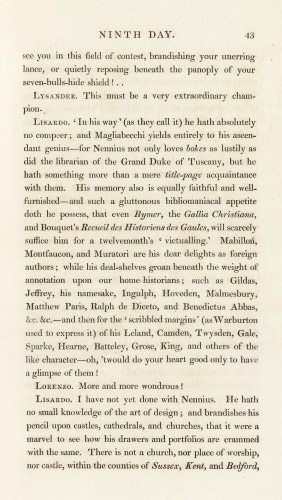 Figure 331
Page of Bibliographical Decameron: Bulmer, London
1817
Figure 331
Page of Bibliographical Decameron: Bulmer, London
1817
-
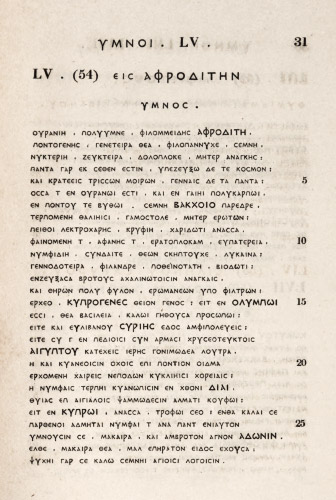 Figure 332
Julian Hibbert’s Uncial Greek Types used in Book of the Orphic Hymns, London, 1827
1827
Figure 332
Julian Hibbert’s Uncial Greek Types used in Book of the Orphic Hymns, London, 1827
1827
-
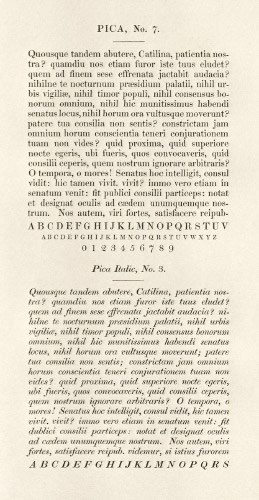 Figure 333
Modern Face Types: Alexander Wilson & Son’s Specimen, Glasgow
1833
Figure 333
Modern Face Types: Alexander Wilson & Son’s Specimen, Glasgow
1833
-
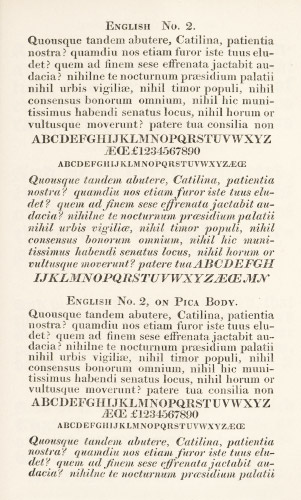 Figure 334
Roman and Italic: W. Thorowgood’s Specimen, London
1824
Figure 334
Roman and Italic: W. Thorowgood’s Specimen, London
1824
-
 Figure 335
Black-letter: W. Thorowgood’s Specimen, London
1824
Figure 335
Black-letter: W. Thorowgood’s Specimen, London
1824
-
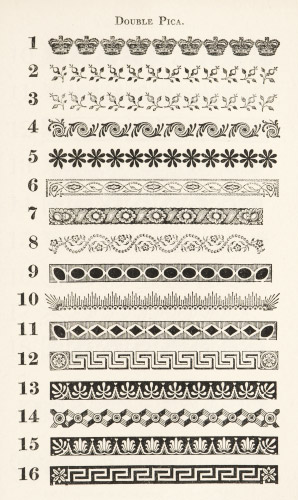 Figures 336 & 337
Ornaments to accompany “Fat-Face” Types: Henry Caslon, London
1844
Figures 336 & 337
Ornaments to accompany “Fat-Face” Types: Henry Caslon, London
1844
-
 Figure 338
Types and Ornaments of Period of the Caslon Revival: Caslon Son and Livermore and Henry Caslon Specimens
1844
Figure 338
Types and Ornaments of Period of the Caslon Revival: Caslon Son and Livermore and Henry Caslon Specimens
1844
-
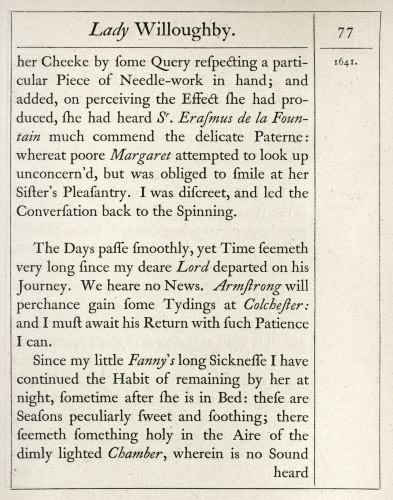 Figure 339
Caslon Type as revived in Lady Willoughby’s Diary by Whittingham, London
1844
Figure 339
Caslon Type as revived in Lady Willoughby’s Diary by Whittingham, London
1844
-
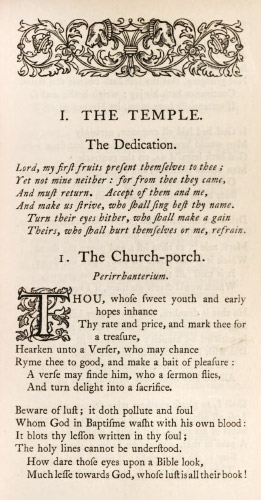 Figure 340
Caslon Type used in “Pickering edition” of The Temple, by George Herbert: Whittingham, London
1850
Figure 340
Caslon Type used in “Pickering edition” of The Temple, by George Herbert: Whittingham, London
1850
-
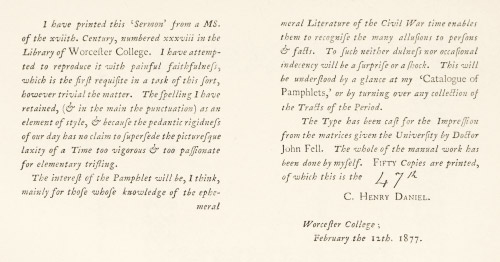 Figure 341
First use of Fell Types by the Daniel Press, Oxford
1877
Figure 341
First use of Fell Types by the Daniel Press, Oxford
1877
-
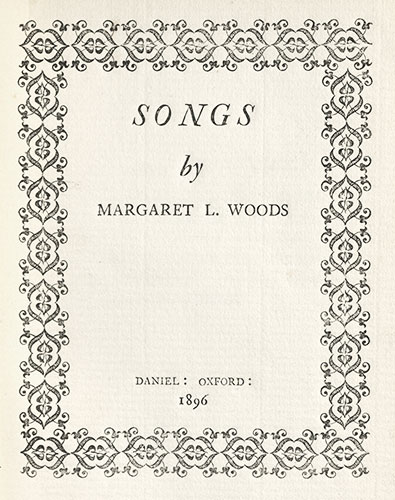 Figure 342
Fell Types as used in Songs by Margaret L. Woods: Daniel Press, Oxford
1896
Figure 342
Fell Types as used in Songs by Margaret L. Woods: Daniel Press, Oxford
1896
-
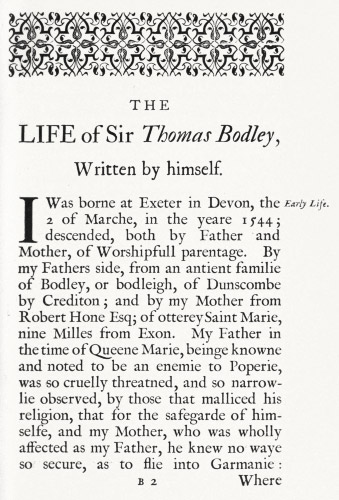 Figure 343
Fell Types as used in Trecentale Bodleianum: Oxford University Press
1913
Figure 343
Fell Types as used in Trecentale Bodleianum: Oxford University Press
1913
-
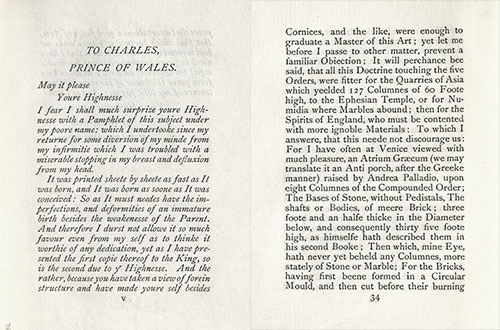 Figure 344
Modernized Old Style Fonts as used in Wotton’s Elements of Architecture: Chiswick Press, London
1903
Figure 344
Modernized Old Style Fonts as used in Wotton’s Elements of Architecture: Chiswick Press, London
1903
-
 Figure 345
Type used in The Hobby Horse: Chiswick Press, London
1890
Figure 345
Type used in The Hobby Horse: Chiswick Press, London
1890
-
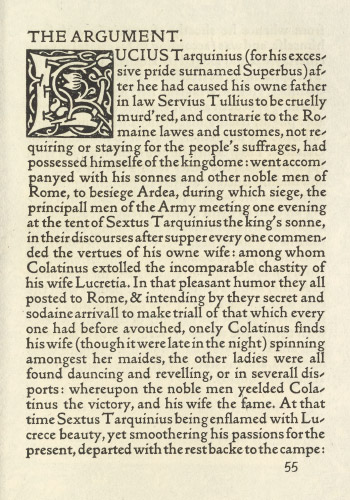 Figure 346
Morris’s Golden Type: Kelmscott Press
1893
Figure 346
Morris’s Golden Type: Kelmscott Press
1893
-
 Figure 347
Morris’s Troy Type: Kelmscott Press
1898
Figure 347
Morris’s Troy Type: Kelmscott Press
1898
-
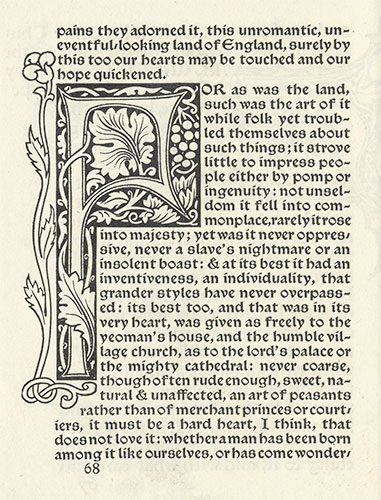 Figure 348
Morris’s Chaucer Type: Kelmscott Press
1898
Figure 348
Morris’s Chaucer Type: Kelmscott Press
1898
-
 Figure 349
The Vale Fount: Vale Press
1904
Figure 349
The Vale Fount: Vale Press
1904
-
 Figure 350
The Avon Fount: Vale Press
1904
Figure 350
The Avon Fount: Vale Press
1904
-
 Figure 351
The King’s Fount: Vale Press
1904
Figure 351
The King’s Fount: Vale Press
1904
-
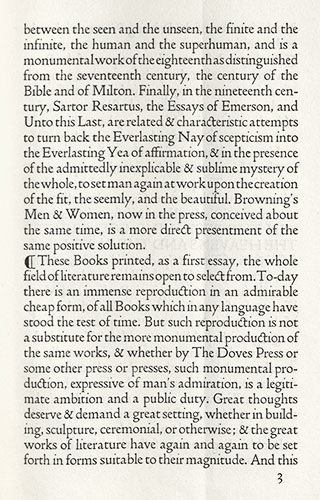 Figure 352
Doves Type: Doves Press
1908
Figure 352
Doves Type: Doves Press
1908
-
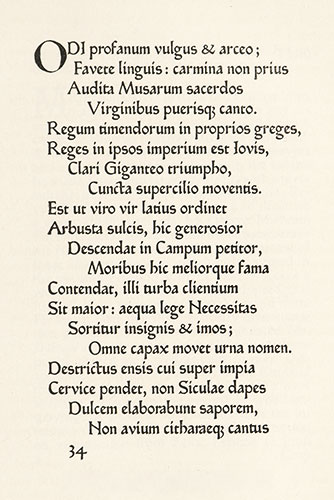 Figure 353
Type used by the Ashendene Press
1903
Figure 353
Type used by the Ashendene Press
1903
-
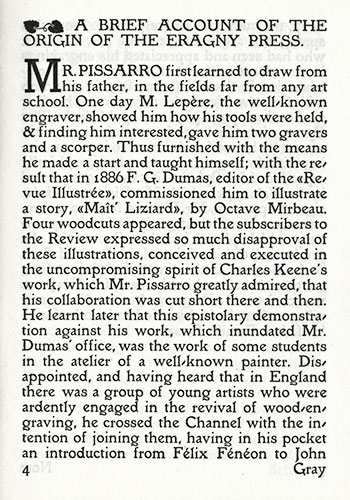 Figure 354
Book Type: Eragny Press
1903
Figure 354
Book Type: Eragny Press
1903
-
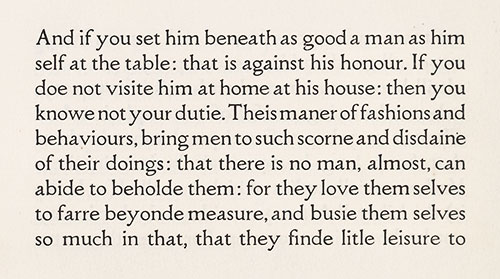 Figures 355 a, b & c
Herbert Horne’s Montallegro, Florence, and Riccardi Types
1904–1914
Figures 355 a, b & c
Herbert Horne’s Montallegro, Florence, and Riccardi Types
1904–1914
-
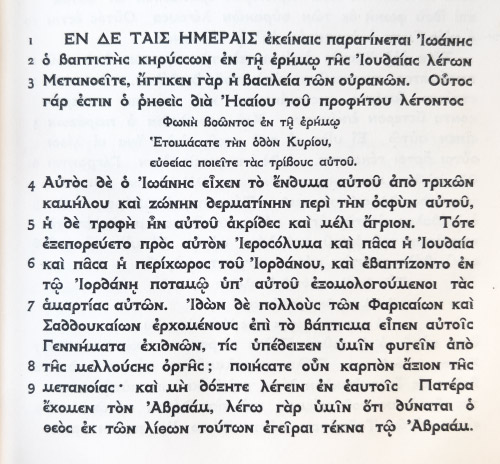 Figure 356
Selwyn Image’s Greek Type
1895
Figure 356
Selwyn Image’s Greek Type
1895
-
 Figure 357
Proctor’s “Otter” Greek Type
1904
Figure 357
Proctor’s “Otter” Greek Type
1904
-
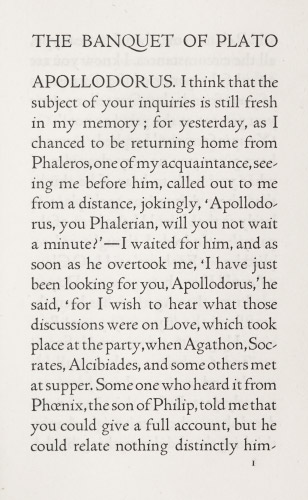 Figure 358
Bruce Rogers’ Montaigne Type
1908
Figure 358
Bruce Rogers’ Montaigne Type
1908
-
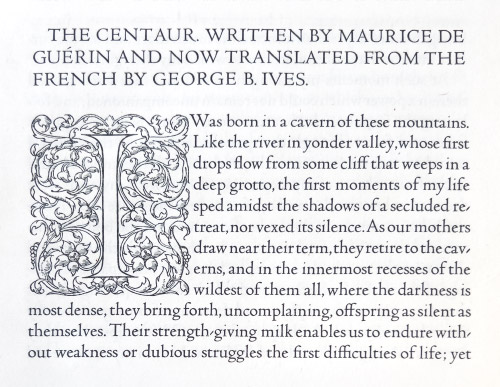 Figure 359
Bruce Rogers’ Centaur Type
1915
Figure 359
Bruce Rogers’ Centaur Type
1915
-
 Figure 360
Bertram Grosvenor Goodhue’s Merrymount Type
1904
Figure 360
Bertram Grosvenor Goodhue’s Merrymount Type
1904
-
 Figure 361
“Inkunabula” type, as used in Risorgimento Grafico: Bertieri and Vanzetti, Milan
1921
Figure 361
“Inkunabula” type, as used in Risorgimento Grafico: Bertieri and Vanzetti, Milan
1921
-
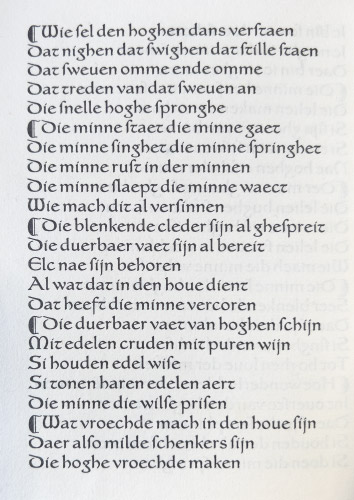 Figure 362
Distel Type: Zilverdistel Press, The Hague
1918
Figure 362
Distel Type: Zilverdistel Press, The Hague
1918
-
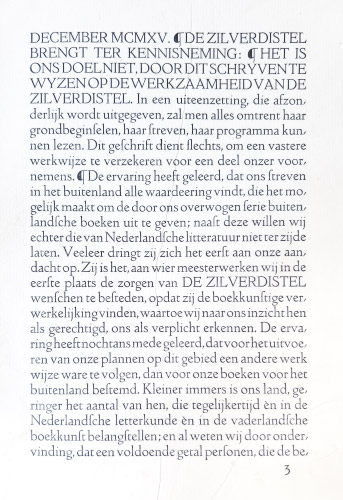 Figure 363
Zilver Type: Zilverdistel Press, The Hague
1915
Figure 363
Zilver Type: Zilverdistel Press, The Hague
1915
-
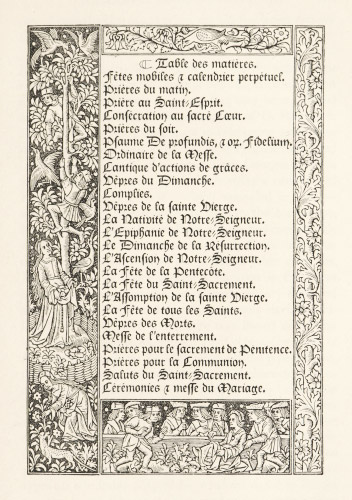 Figure 364
French Lettre Batarde, Paris
1890
Figure 364
French Lettre Batarde, Paris
1890
-
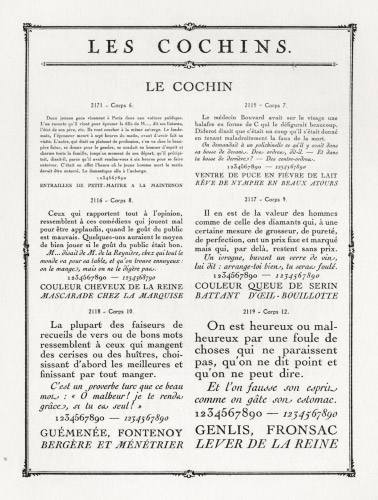 Figure 365
Le Cochin: G. Peignot & Files, Paris
1914
Figure 365
Le Cochin: G. Peignot & Files, Paris
1914
-
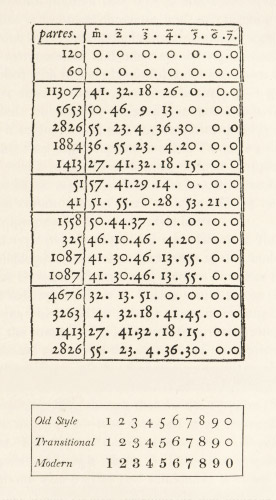 Figure 366
Arabic Figures used by Simon de Colines in 1536 (top) with Arabic Figures, Non-Ranging and Ranging (bottom)
1536
Figure 366
Arabic Figures used by Simon de Colines in 1536 (top) with Arabic Figures, Non-Ranging and Ranging (bottom)
1536
-
 Figure 367
Examples of Transitional Types
Figure 367
Examples of Transitional Types